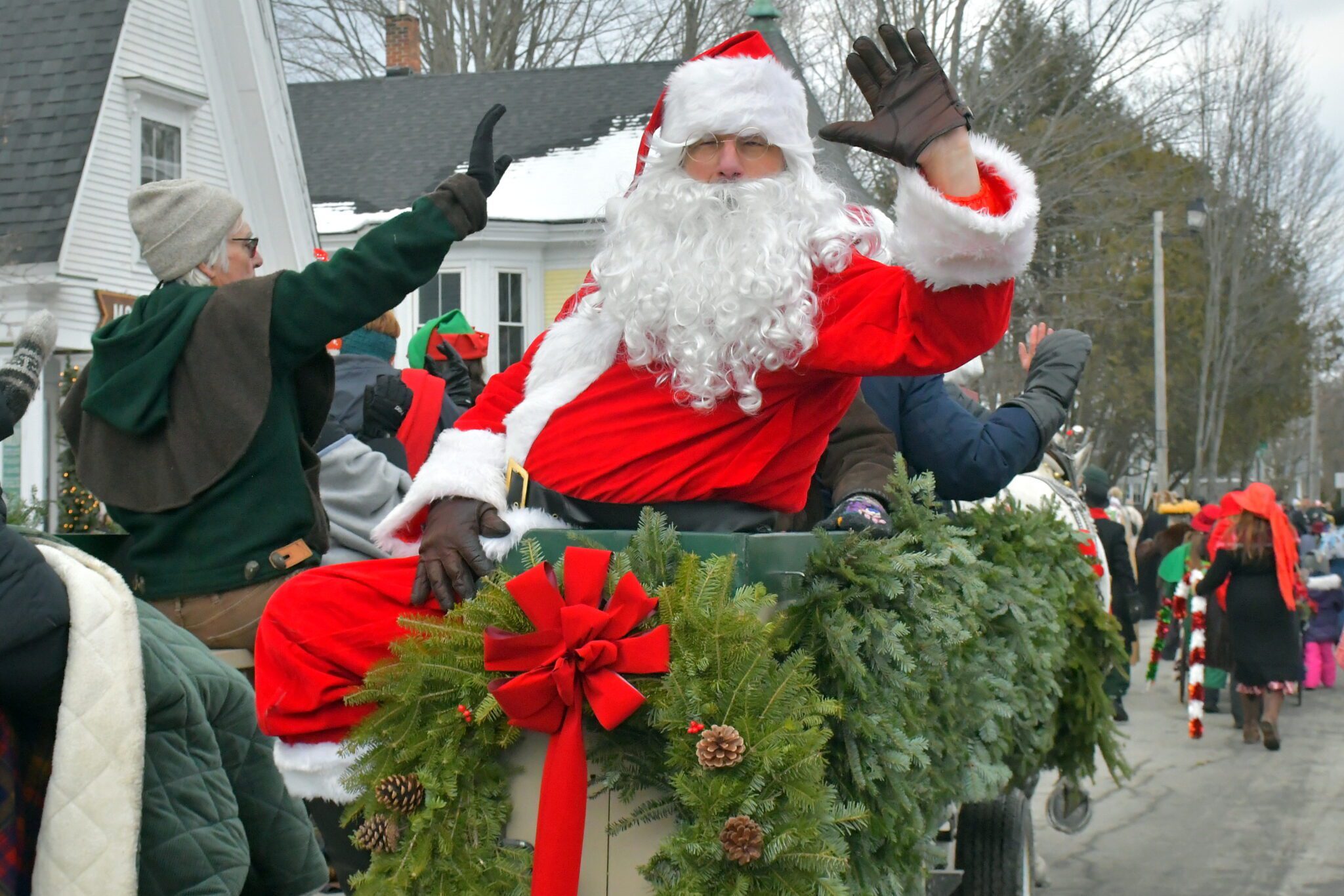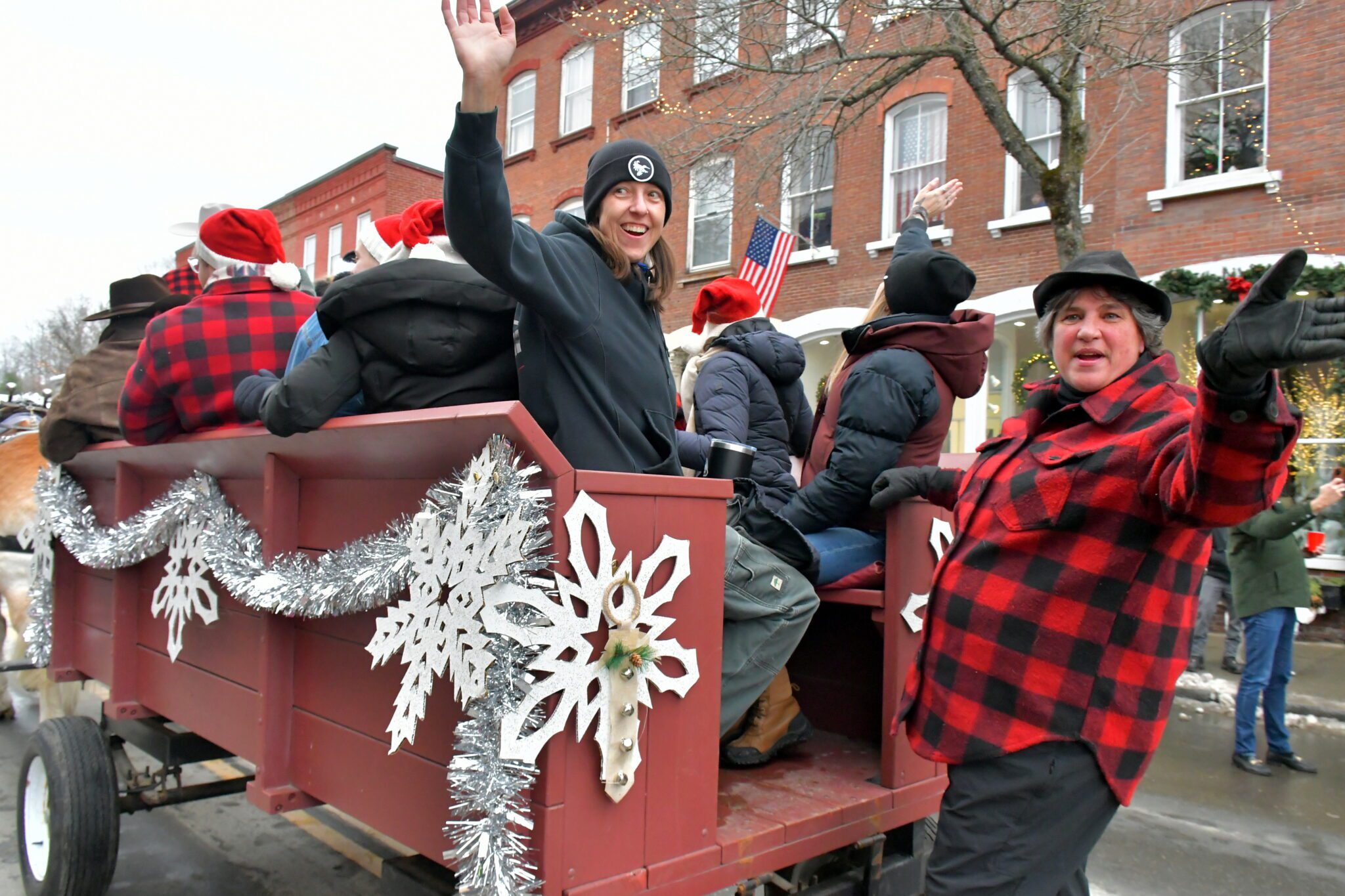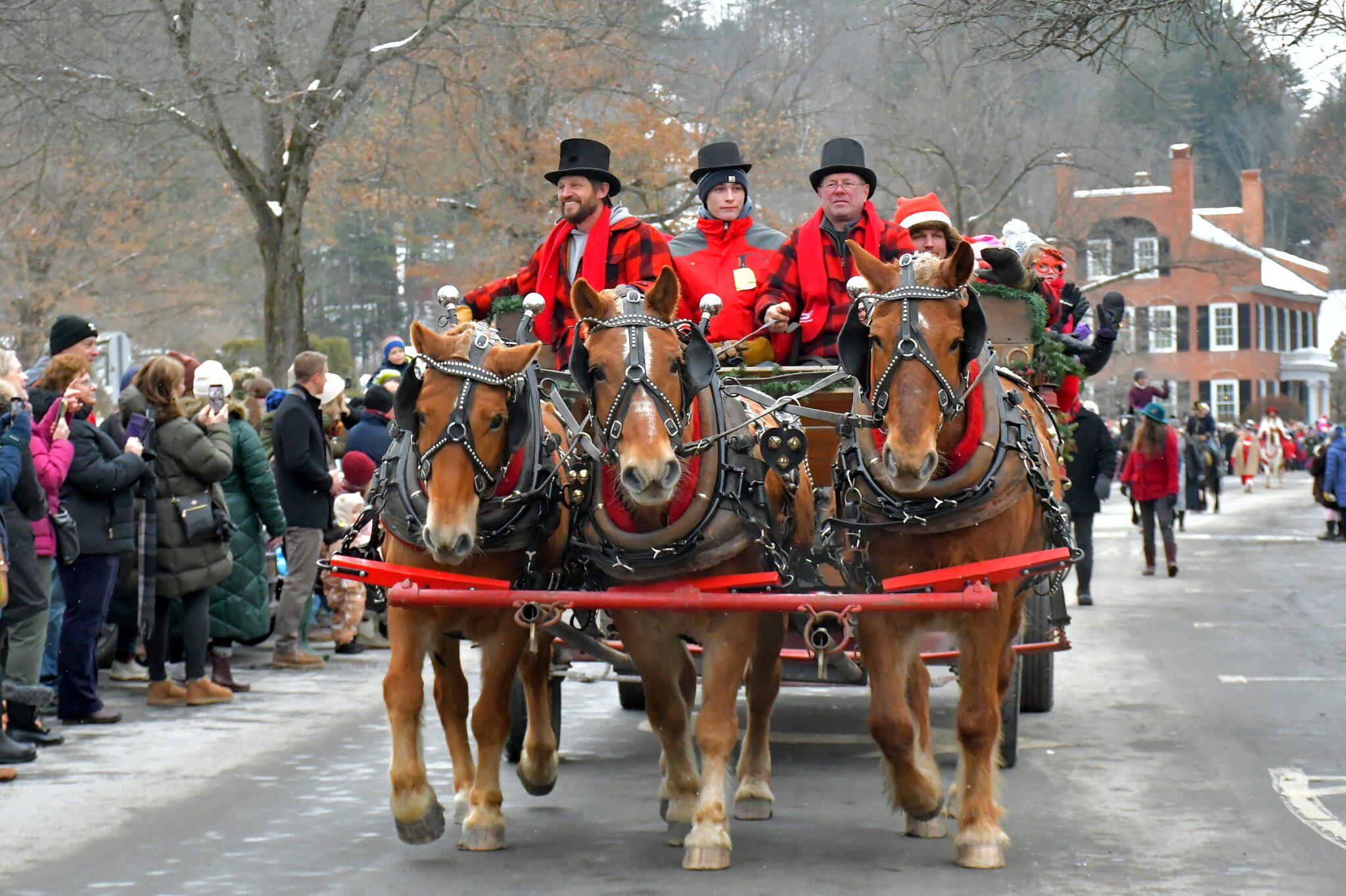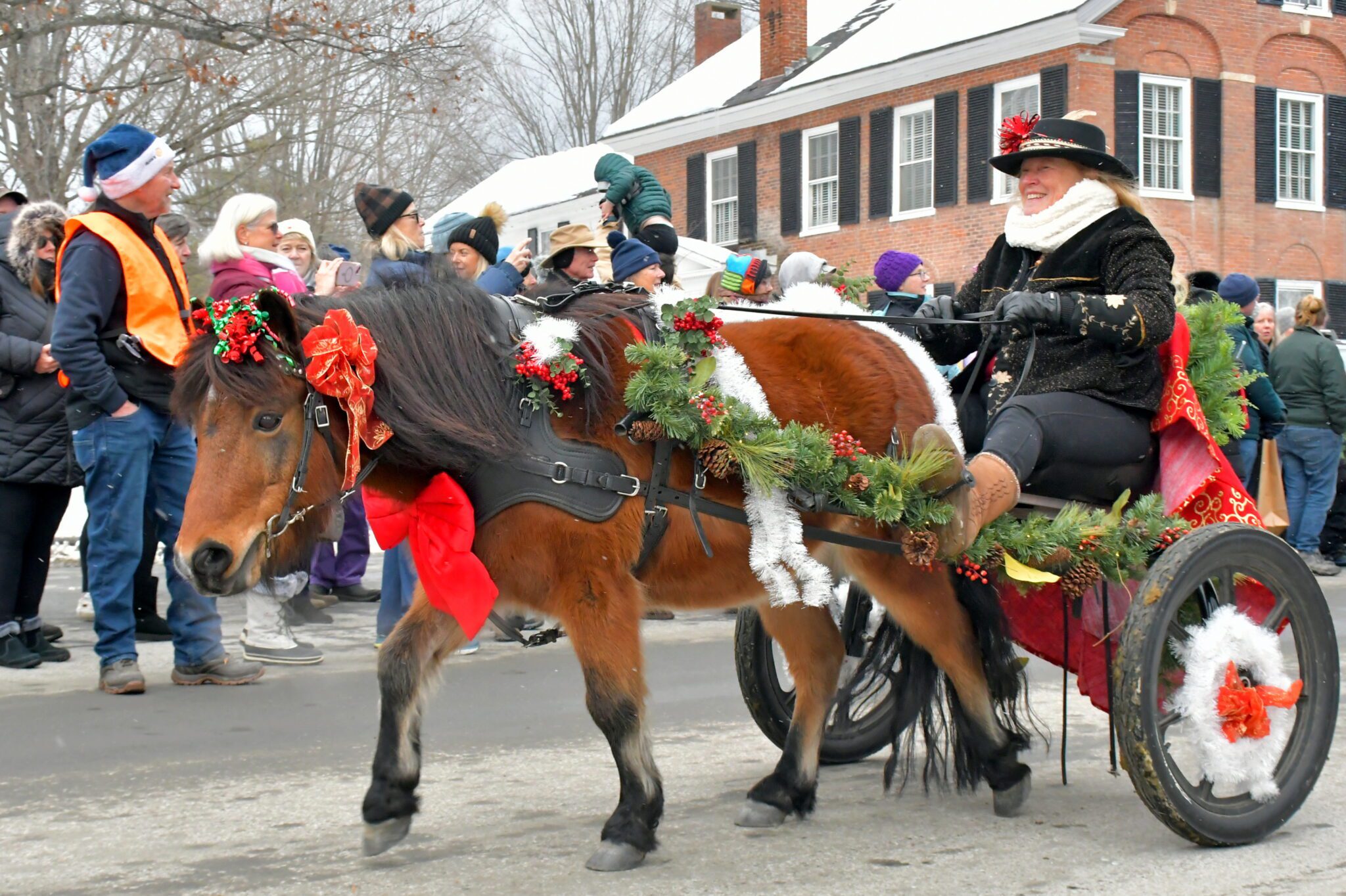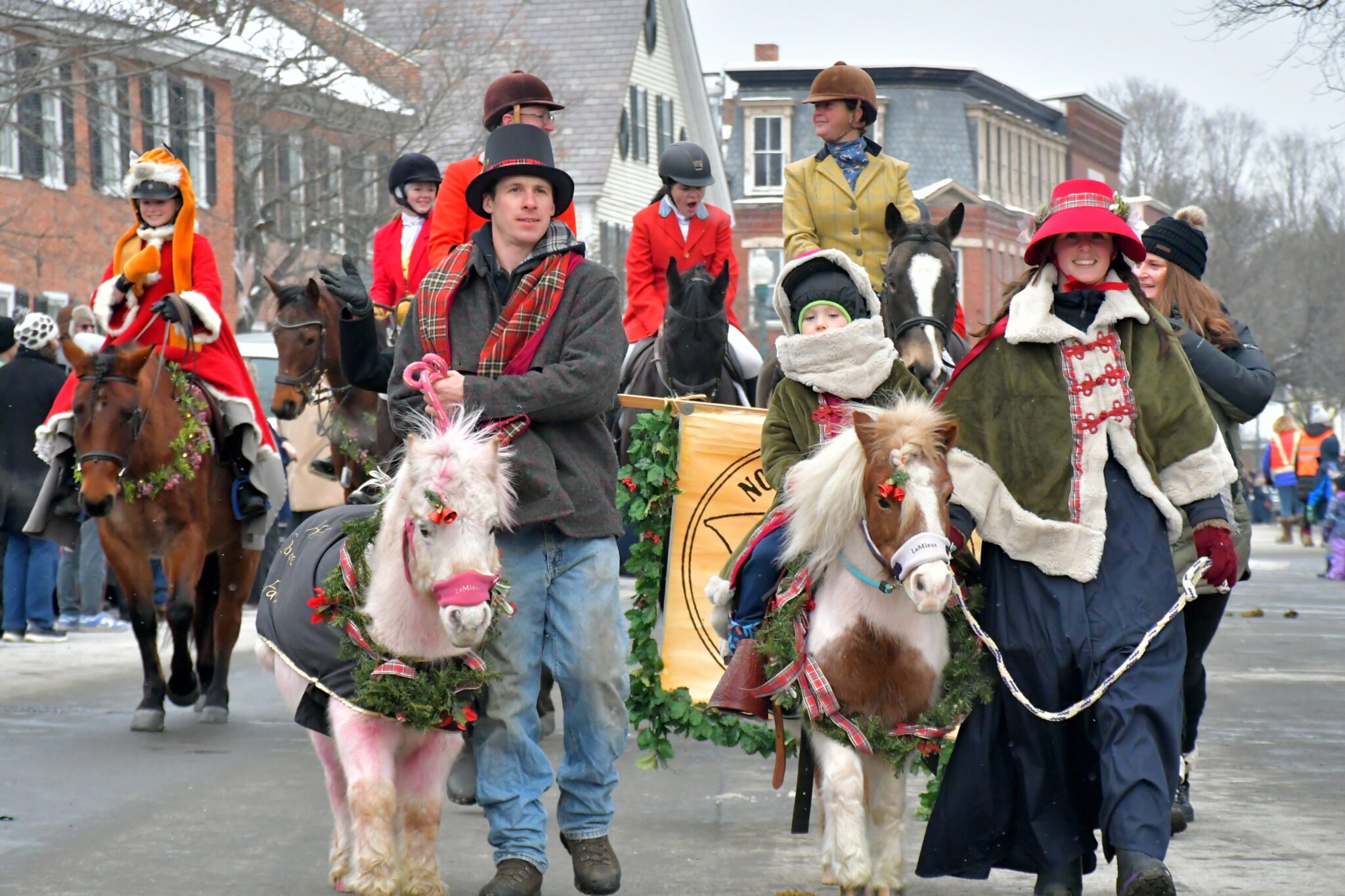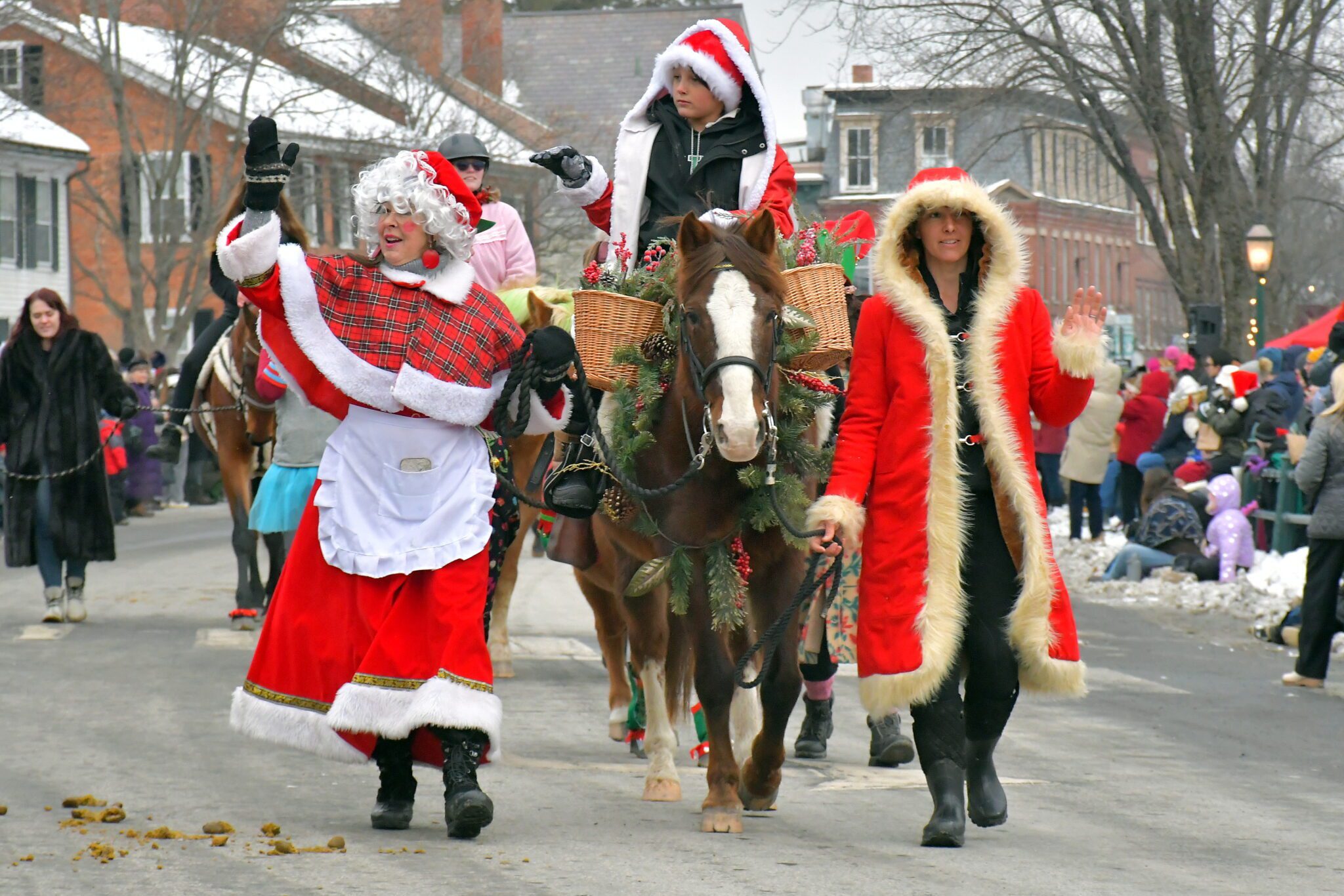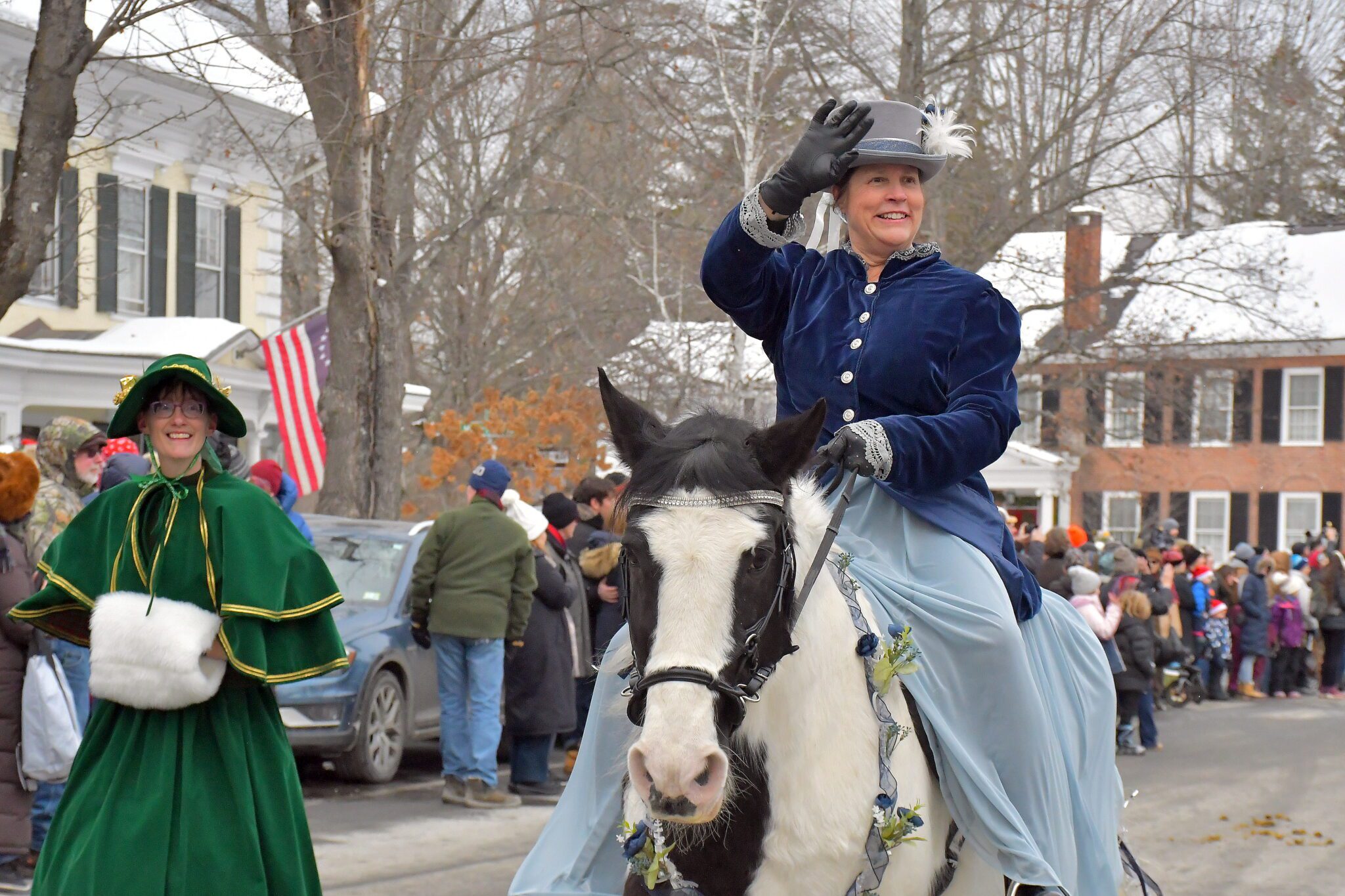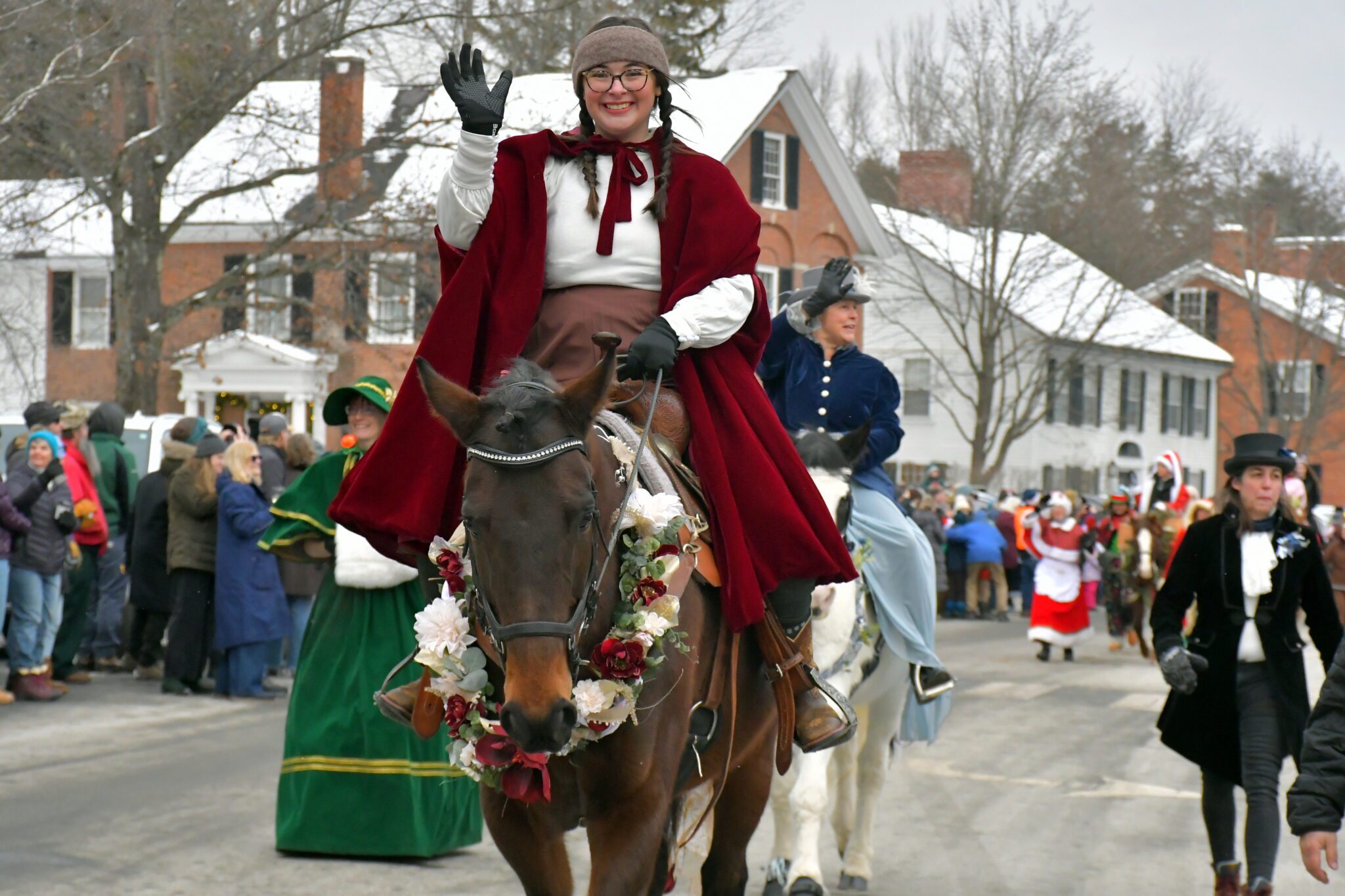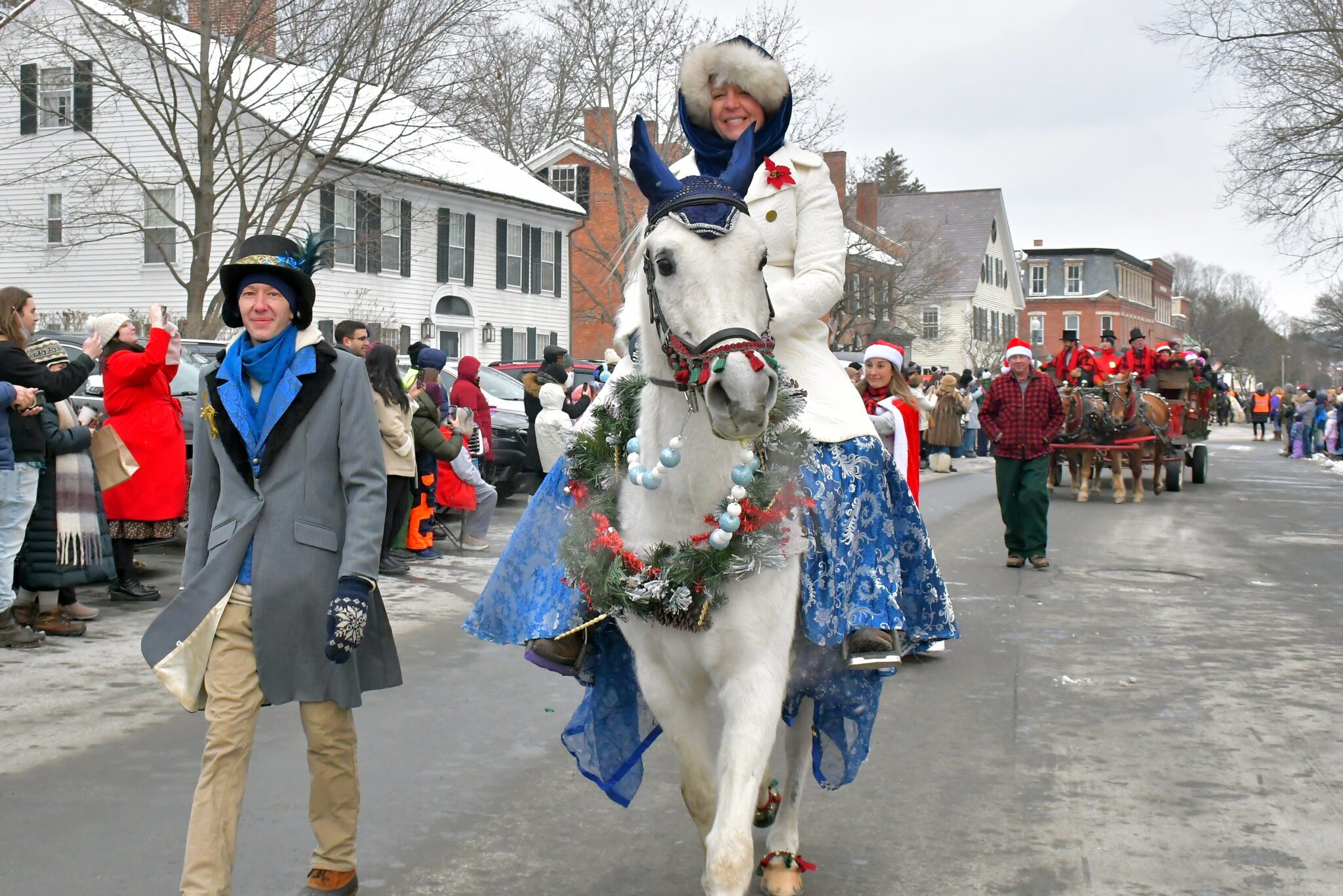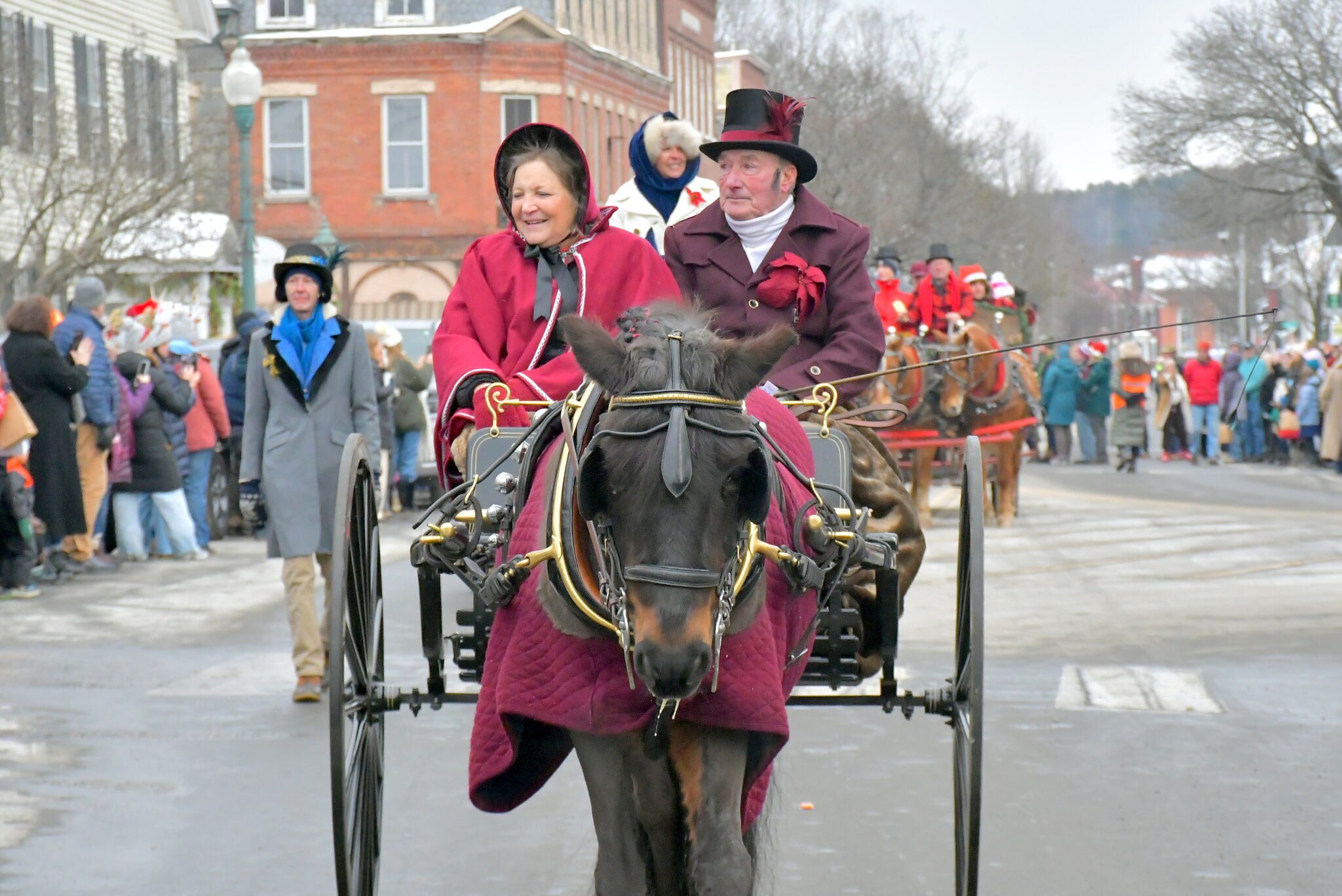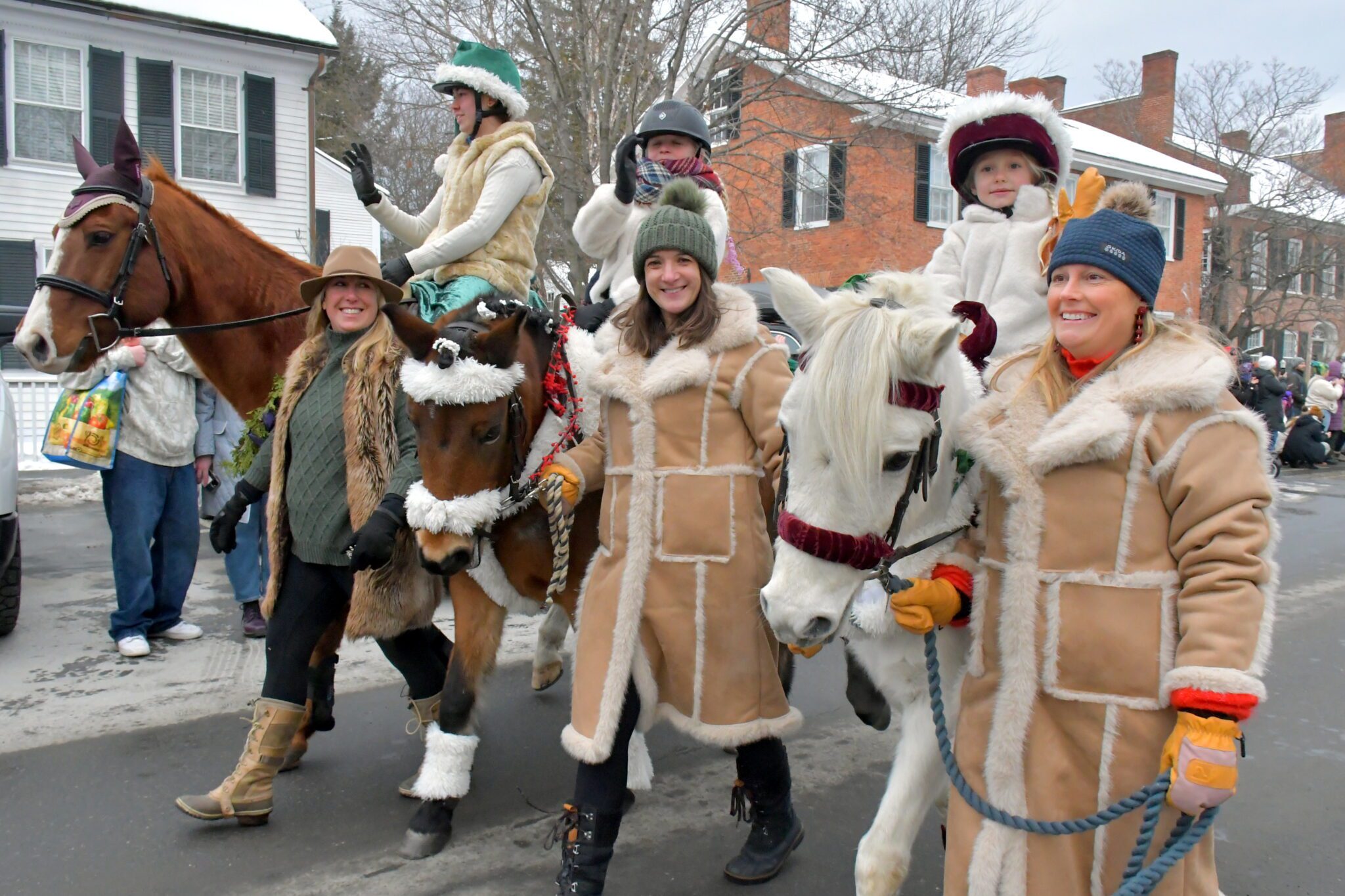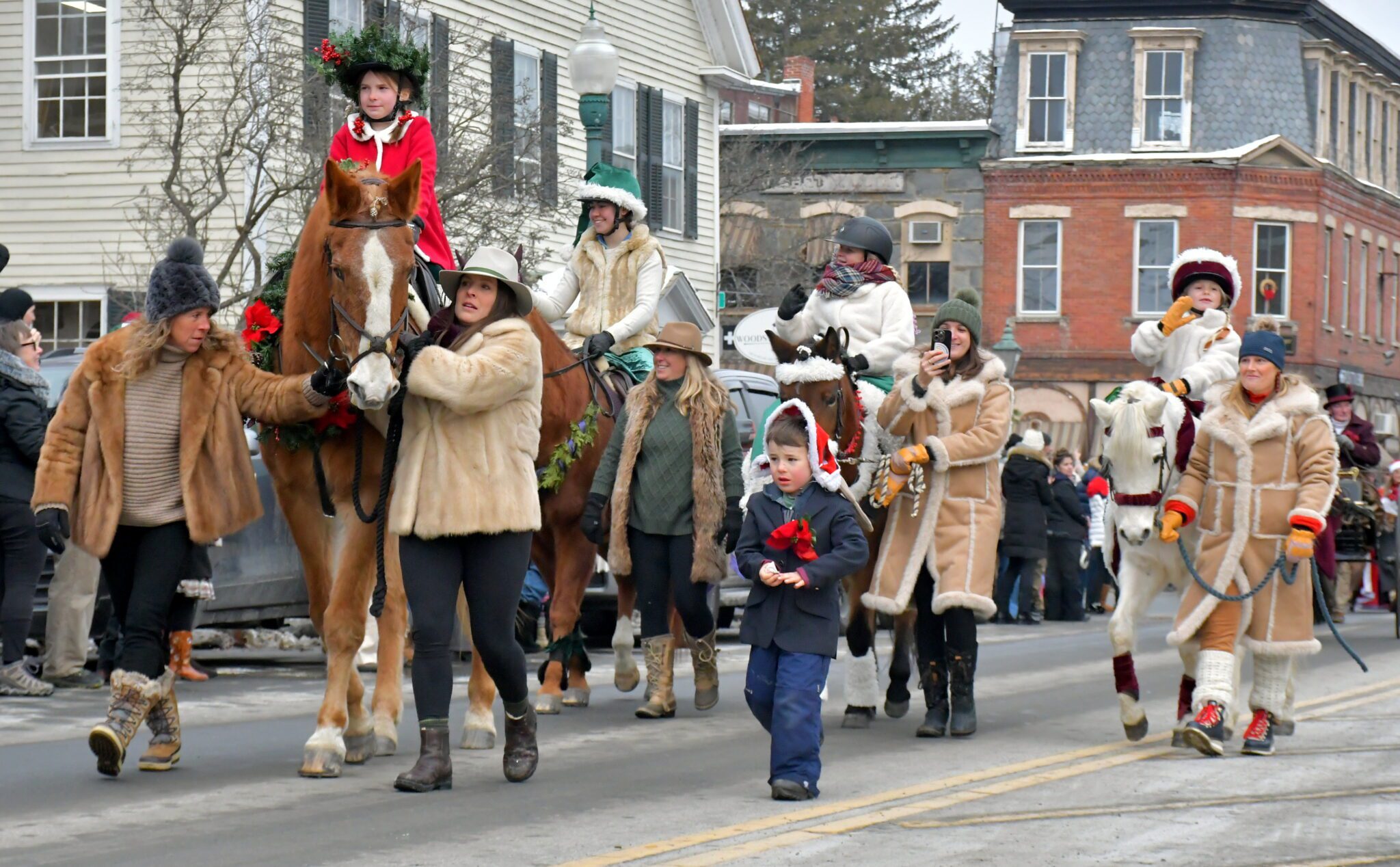
WOODSTOCK
- Barnard
- Bridgewater
- Hartland
- Killington
- Plymouth
- Pomfret
- Quechee
- Reading
- South Woodstock
- South Woodstock
- West Windsor
Please support the Vermont Standard 2025 Annual Appeal. Help now.

Surprenant steps down as Windsor-4 state rep to pursue her passion for farming
Woodstock architect acquires building that previously housed Melaza Bistro
Barnard robotics team headed to state championship again this year

Act 250 commission hears request for demolition of South Street homes
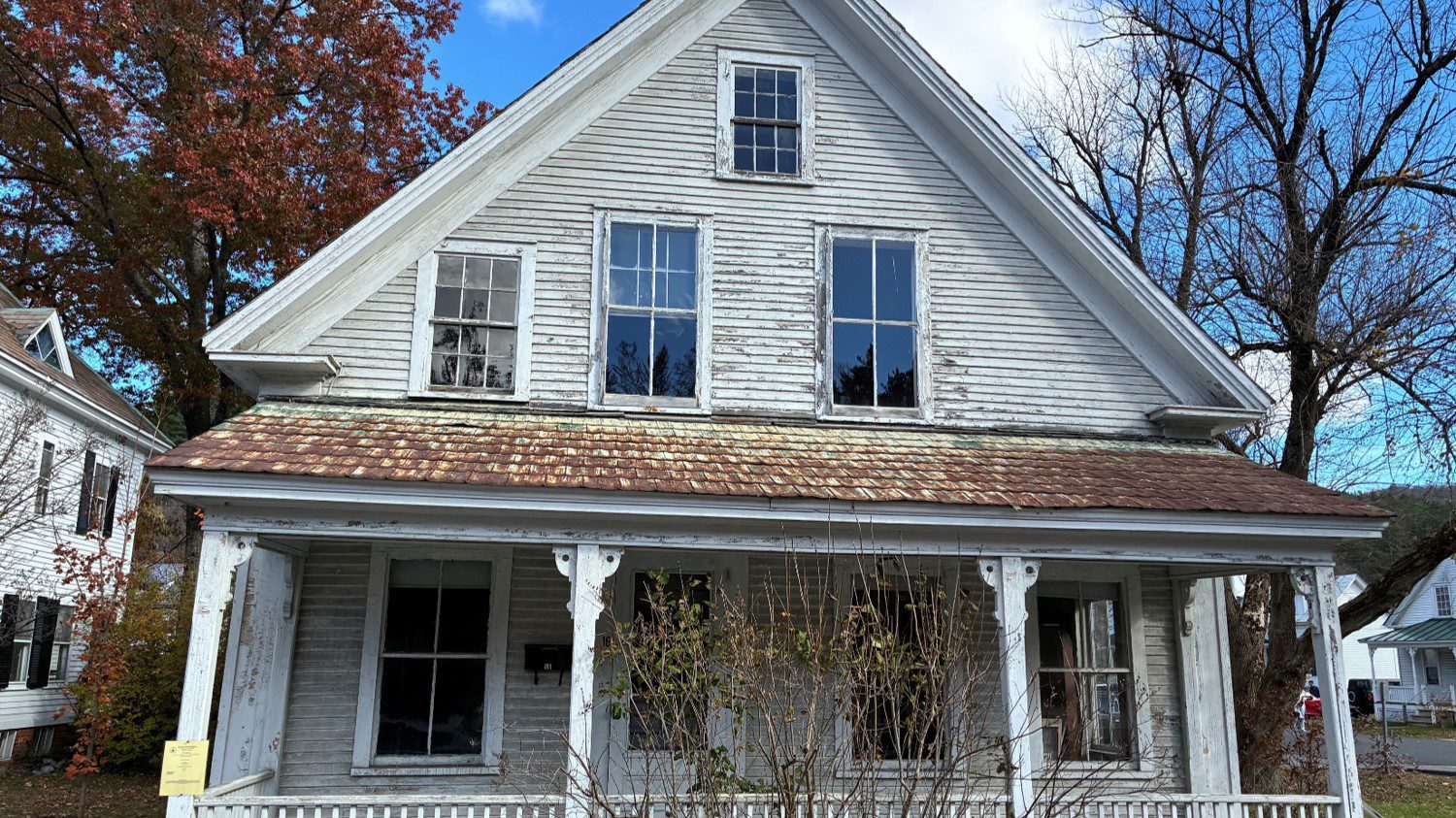
Woodstock receives grant to explore flood mitigation at mobile home park
School board will ask voters to okay $32.5M budget for next year
Recent Sports Scores

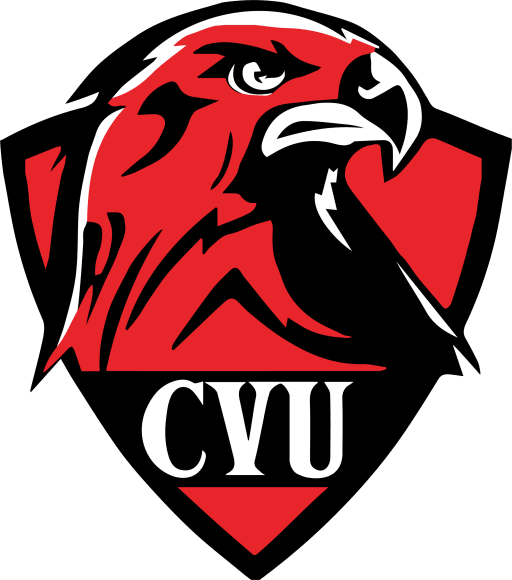



News
December 18
6:56 am
Swanson's lawyer asks court to order Village to comply
By Mike Donoghue, Senior Correspondent
Demoted Woodstock Police Chief Joe Swanson has asked a state judge this week to order the village to comply with state law and judicial orders from his case in Vermont Superior Court.
Swanson, who was placed on paid administrative leave again, continued his fight this week to be reinstated as the police chief for the Village of Woodstock with his latest filing in Vermont Superior Court.
Among other things, Swanson wants the village to resume paying him at his contracted rate he received when serving as police chief. He also is seeking back pay “during the time he was unlawfully demoted.”
Swanson also is requesting the court to protect his due process rights as the village tries to block him from returning as police chief.
Swanson maintains the village’s actions, including reclassifying him as a patrol officer, reducing his pay and denying back pay during the demotion “violate clearly established legal rights which are not discretionary.”
The latest motion by Swanson this week is a legal request known as a “writ of mandamus,” which is seeking the court to command an action often times by a government official or entity.
Burlington lawyer John Klesch, who represents the Village of Woodstock, said Tuesday afternoon he was aware of the latest filing made by Swanson’s lawyer, Linda Fraas of Manchester, N.H.
Klesch said he had not had time to read the filing, which is more than 50 pages, including exhibits. He said a written response will be made to the court.
Trustee chair Seton McIlroy told the Vermont Standard last week that her board held another private deliberative session after the judge ruled. She said the village is planning to conduct another demotion hearing in March at the earliest.
Municipal manager Eric Duffy, who ordered the demotion, did not respond to voice and text messages from the Vermont Standard.
Duffy was scheduled this week for public interviews in Winchester, Mass. where he is one of three finalists for the post of town manager.
Fraas said Judge H. Dickson Corbett was clear in his findings in the Rule 75 appeal that the village trustees failed to follow the law when they considered the demotion. Now, Fraas filed a new Rule 75 request.
“Contrary to the clear language of this Court’s final judgment in a prior Rule 75 action reversing Respondent’s unlawful demotion of Petitioner, Respondent unlawfully insists upon keeping Petitioner in a patrol officer status with patrol officer pay,” Fraas wrote.
She now wants the village to respect the judge’s ruling.
Fraas noted Swanson began as a part-time officer in Woodstock in 2000, later moved up to fulltime status and was promoted to corporal in 2013. He served as a sergeant from 2014 to July 2023, when Duffy named him police chief after a national search.
Things went smoothly for over a year, but Duffy placed Swanson on paid administrative leave on Oct. 15, 2024 and demoted him on Feb. 23 after hiring a private detective to interview police employees and town emergency dispatchers.
Some mentioned they were not happy that the chief had a messy office, wore non-matching socks and had messy hair. They also said the chief did not tell employees where he was going when he left the police station and didn’t always answer his cell phone.
The village trustees heard Swanson’s appeal during a 14.5-hour marathon hearing on March 19. The trustees announced on April 17 that they would uphold Duffy’s decision.
Fraas then filed the police chief’s appeal in Vermont Superior Court on May 7, claiming an abuse of governmental authority based on the village’s unlawful demotion of Swanson that was “contrary to established contract and employment law.”
While the case was pending, Judge Corbett issued a preliminary injunction on Aug. 7 to block the village from hiring a permanent police chief. Sgt. Chris O’Keeffe remains the interim chief.
Judge Corbett ruled on Dec. 2 a final judgment on Swanson’s appeal and concluded the village “failed to apply the correct standard of ‘just cause’ for removal of its Police Chief.”
In this week’s filing, Fraas added, “This court stated that because the trustees did not make their decision according to the correct legal standard, the April 17th decision of the village trustees is reversed.”
Fraas has maintained the village and Duffy did not have “just cause” and now are trying to use “just because” as the excuse.
“This Court’s reversal of the unlawful demotion was deemed a ‘final judgment,’” Fraas wrote this week.
She went on to say she sent a note on Dec. 2 to Burlington lawyer Brian Monaghan, who served as the hearing officer and legal counsel for the village trustees. She asked for the proper reinstatement to chief with back pay from the time of the demotion.
Swanson received the court order while on vacation and wrote to the department about 3:42 p.m. Dec. 2 that the demotion had been reversed and he was coming back as chief, Fraas wrote.
Klesch wrote back to Fraas about 70 minutes later that Duffy planned to send an email to the department that he still considered Swanson a patrol officer.
The two sides continue to have a spat, but in her filing Fraas wrote that the village’s “actions constitute abuse of governmental authority as a matter of law.”
She also maintains the village’s “refusal to award Swanson back pay is unlawful.”
Fraas said she remains deeply concerned that Woodstock unlawfully intends to allow the village trustees, who are or have been named as defendants in Swanson’s $5 million improper discharge civil suit to help adjudicate future termination proceedings.
December 18
6:55 am
Surprenant steps down as Windsor-4 state rep to pursue her passion for farming
Heather Surprenant, a Barnard resident and former Windsor-4 House Representative, says she left state government in September to pursue a deeper investment and commitment to the farmland she fell in love with long ago.
“I’ll start by saying that I have been farming for thirteen years,” Surprenant told the Standard. “That is where my career, passion, and area of expertise have lied, and farming will be my guiding focus moving forward.”
“I have been in the legislature for the past five years, serving in the Agriculture Committee. More recently, in the past three years, I have served in the vice chair position. I felt deeply honored to have been so connected to Vermont agriculture and to have been able to have a platform on more of a statewide level to enact some of that policy and to integrate some of my personal with the professional. This experience has been deeply valuable and humbling. The decision to step away was not made lightly.”
Surprenant went on, “There comes a time of deep recognition and reflection in yourself — a questioning of, ‘Do I feel like my energies and efforts are being put to best use in this position and are they in alignment with the ways in which I want to engage with my community?’ In spite of being in a prominent position on the Agriculture Committee, and in spite of having a position of leadership within the Democratic Party doing their internal communications, I think I still was feeling like I was falling short in the specific advocacy around farming that brought me into the legislature in the first place.”
“My decision to step away is really rooted in the fact that it has proven difficult for me, in the past five years, to continually try to convince a 150-member body why small-scale sustainable agriculture should continually be invested in. I don’t want to be a performative politician and only celebrate farmers when it’s advantageous for a campaign, but rather actually advocate for farmers in a considered, fiscal manner. I am someone who believes farming touches on every aspect of social justice. From land access to food access to immigration and workforce development, farming holds traditional heritage in our state, and I sadly felt alone in that work at the state level,” Surprenant said.
Now, Surprenant hopes to return to her roots. Growing up in Randolph, Surprenant was exposed to farmland, but she found her passion for agriculture after college. She told the Standard, “I went to college at Smith for politics, and then moved to San Francisco to pursue human rights law. I ended up working at a tech firm doing patent law, and it was one of the most soul-sucking experiences. I realized this lifestyle, this work, was not touching upon any of my dreams. So, I quit at twenty-two and started working at a farm in Half Moon Bay, just south of the city. We grew organic vegetables, had a 350-member CSA (community supported agriculture), and delivered to the greater San Francisco area. I fell in love with working on the land. I fell in love with being outside and moving my body. I fell in love with the idea that I could talk about everything that was important to me. I could engage with social justice issues, immigration rights, housing and land access, climate justice, feeding people, and food deserts.”
Even though politics was not the right place for Surprenant to feel fulfilled and to flourish, she looks back fondly and humbly on the work she was able to achieve at the state level. Surprenant told the Standard, “When I look back, it is easy to point to specific policy I feel proud to have worked on. During my second term, I co-sponsored a bill with the former representative of Williamstown, Rodney Graham. He was a Republican on the Agriculture Committee. He was an old-school Vermonter, a deep conservative and long-time farmer. I was a progressive young first-generation Vermonter, and we came together to co-author a bill that would give specific financial preference to small farmers who were wanting to diversify their farming operations. This piece of legislation was specifically important because a lot of the funding through the state is allocated to big farms. It goes to farms who can provide a financial match for those grants, and it is suffocating the small farms who are desperately in need of that funding to maintain and sustain themselves. This bill was a momentous situation where two people on opposite ends of the political spectrum agreed that small farms are the heart of Vermont agriculture and deserve to be saved and prioritized. It was a poignant collaboration that passed unanimously on the floor of the House. Every farm awarded this grant receives $250k, and it has become one of the highest in-demand grants across the state.”
While Surprenant is saddened that, with her resignation, these small farms will likely lose one of their most zealous advocates, she is confident she can find a place to still help farmers — with boots on the ground and hands in the soil.
Surprenant has been succeeded by Michael Hoyt as the new Windsor-4 Representative.
For more on this, please see our Dec. 18 edition of the Vermont Standard.
December 18
6:55 am
Woodstock architect acquires building that previously housed Melaza Bistro
A longtime Woodstock-area architect, designer, and builder has acquired the commercial property at 71 Central Street in Woodstock Village, which previously housed the Melaza Bistro restaurant.
Alfonse Sorrentino of ACS Design/Build, Inc., closed on the purchase of the Central Street property on Dec. 5. The previous owner of the commercial building was Lynn Simmons, a Florida resident, according to Woodstock realtor John Wetmore, who handled the real estate transaction.
Contacted by phone on Tuesday morning, Sorrentino spoke about his tentative plans for the renovation and reinvention of the 71 Central Street commercial building — plans that he said were still “very much in flux.” The building presently includes three separate condominium units on two floors. Melaza Bistro previously leased three-quarters of the space for its restaurant, kitchen, and office operations, Sorrentino said.
“At this point, I believe the upper level will be used for residential — one or two condos — and the lower space will most likely be for retail or a restaurant, some commercial use,” Sorrentino said on Tuesday. “It’s going to be up to the end user. I have some pretty strong ideas of what would work in that lower space, but ultimately, I would either be a landlord or sell the three spaces. They will all be condominiums. Those are currently my tentative plans. I recognize that it’s a significant location in the downtown commercial zone. The building was in terrible disrepair, and I think it has some real potential,” Sorrentino continued.
The developer did not spell out a specific timeframe for the building renovation. “I think I’m going to do repairs and the additions — they will happen first — and then I don’t know when we’ll come to market with the finished products. Who knows? Maybe we’ll come to market before they’re completely built out, in particular, the retail space. It would be nice to partner with the end-user early on in the process, absolutely. Right now, I really don’t have a whole lot of information that you can hang your hat on.”
Melaza Bistro ceased operations at 71 Central Street in November, as the sale of the property to Sorrentino was being finalized. During a brief Tuesday afternoon phone conversation, Melaza chef/owner David Diaz said he was not yet prepared to say what his plans might be to operate any future restaurant in Woodstock.
December 18
6:55 am
Woodstock Chamber of Commerce announces new executive director
On Monday, Dec. 15, the Woodstock Chamber of Commerce announced Bridgewater resident Jim Kelly as its new executive director.
Beth Finlayson will end her tenure as executive director at the end of this month. In the new year, Kelly will step into the role.
“Kelly brings a strong commitment to the region and its small businesses, and a deep appreciation for the people, landscapes, and enterprises that make the Woodstock area thrive,” Chamber president Loren Fisher told the Standard. “He is first and foremost a Woodstock man. He grew up here, knows the community, knows the businesses. He has a deep love and passion for this place, and I know he will help all of our businesses thrive.”

Jim Kelly
For Fisher, it was important to choose a candidate capable of balancing and aiding businesses impacted directly by tourism, as well as those not affected at all. “We live in a tourist-based town, but it is important that we are servicing all aspects of this community. We want to incentivize businesses and help each business feel included, even if they fall outside the scope of tourism,” Fisher continued. “The second you meet Jim, it feels like you’ve known him forever. It’s this friendliness that will be a welcome presence to each business we support and engage with.”
“With a strong background in sales and marketing, and the skill set to provide a service to each business, I think Jim can help the Chamber not only survive but truly thrive.”
Fisher and the rest of the Chamber board looked at several candidates across the Upper Valley. “While it was not a nationwide search,” Fisher told the Standard, “It was important for us to be community-based and select a person who knew Woodstock well, especially following Beth [Finlayson] and her strong community presence here during her tenure.”
For more on this, please see our Dec. 18 edition of the Vermont Standard.
December 17
6:55 am
Act 250 commission hears request for demolition of South Street homes
On Tuesday morning, the District 3 Environmental Commission, part of the Land Use Review Board, reviewed the Woodstock Inn & Resort’s application to demolish two South Street homes. As stipulated at the start of the hearing, the commission would hear from both the Inn and community members and ultimately decide if the application for the demolition in question complies with each criterion for the commission to issue a Land Use Permit.
The Act 250 criterion deals with air and water pollution, water supply, erosion to soil, transportation, educational services, municipal services, and ecosystem protection, scenic beauty, and historic preservation.
After reading opening statements, the commission allowed those in the audience to apply for party status, meaning that they have a specific vested and prioritized interest in this matter and would be given the power to question and rebut the applicant’s testimony. This status was awarded to Jeffrey Kahn, Robert Pear, Philip Neuberg, Wendy Wright Marrinan, Wendy Spector, Melissa Tarlow, Michael Richie of the Norman Williams Public Library, and Jenna Lapachinski with the Vermont Preservation Trust. The main reason many asked to be given this rebuttal ability is that they felt strongly about the historic preservation, economic health and vitality, and potential pollution that could be caused by the demolition of the two South Street homes.
The hearing then commenced with Benjamin Pauly, director of property operations and design at the Inn, addressing the commission and laying out the entire timeline of the 14 and 16 South Street properties. In his presentation, Pauly explained, “The properties had been considered for renovation in the 1980s to be turned into guest housing, until a letter from Human Resources dated 1983 declared that employee housing was more important, and thus the homes were used as such, but never renovated. When the furnace in each respective home broke in the early 2000s, the Inn had no need for extra employee housing and decided it did not make sense financially to repair either home at the time.”
According to Pauly, a number of small repairs have been done over the years, including painting clapboards, floor repairs, and fixing leaks in the roof. The larger renovations that would need to be completed in order to make the two homes habitable have not been completed, as both homes have sat cold and empty for over twenty years. “With price increases and inflation, each home would cost around $3M to renovate, as the process would require new roofs, a fixed furnace, new paint jobs, gutting the entire space to rid the homes of mold, and much more. It does not make financial sense for the Inn to renovate these homes when there is no use for them,” Pauly added.
Neuberg and Marrinan raised objections to this point, as they said adequate maintenance of the properties is a requirement to approve an application to demolish.
A discussion followed regarding the potential environmental impacts and pollutants a demolition would entail, as well as the ethics behind demolition of two historic homes. A number of residents spoke, advocating for the Inn to seek another solution.
After five hours, chair of the commission, Cheryl Harvey, addressed those in attendance, saying, “Thank you all for your participation. The commission will reflect on all the evidence and testimony presented today. Following this, the commission may issue a hearing recess that keeps the record open for a period of time.”
She explained that, typically, a hearing recess order asks the participants and sometimes other parties to submit supplemental information in response to the questions that have been raised and allows parties an opportunity to respond to these supplemental filings. “Once the process is complete, the commission will consider the record to be final once we have all the supplemental information that we need,” Harvey added. “We’ll deliberate and issue our decision as expediently as possible.”
For our full story on this, please see our Dec. 18 edition of the Vermont Standard.
December 17
6:55 am
Woodstock receives grant to explore flood mitigation at mobile home park
The Town of Woodstock has received a $200,000 community development block grant (CDBG) to study flood-mitigation opportunities at the Riverside Mobile Home Park.
The grant will go toward engineering studies to figure out how to best reduce the mobile home park’s flood risks, including one that will look at relocation sites for homes deemed most at risk of being flooded, Woodstock municipal manager Eric Duffy said in a press release last Friday. The grant only funds planning and not the implementation of strategies that may emerge from the engineering studies, the statement from Duffy noted.
The disaster recovery grant to Woodstock was part of a $49 million package of grant awards in response to the disastrous July 2023 flooding that struck a wide swath of Vermont. The first round of grants was announced by Vermont Gov. Phill Scott, U.S. Senators Bernie Sanders and Peter Welch, and U.S. Rep. Becca Balint on Dec. 11. The funds are intended to benefit communities most impacted by the floods in regions designated by the U.S. Department of Housing and Urban Development in consultation with state officials, according to a media release from Scott’s office. The areas designated as the most adversely impacted by the 2023 flooding include Lamoille, Washington, Caledonia, Orleans, Rutland, Windham, and Windsor counties, the governor’s office reported.
Addressing the CDBG disaster relief grant to Woodstock, Duffy offered, “This project reflects Woodstock’s commitment to protecting our residents and planning responsibly for climate change. Riverside is an important part of our community, and every household deserves to feel supported as we navigate long-term flood recovery and beyond.”
In announcing the first round of disaster recovery grants tied to the July 2023 floods, Scott, Sanders, Welch, and Balint noted that there will be a second round of CDBG funding available early in 2026, totaling $14.46 million.
For more on this, please see our Dec. 18 edition of the Vermont Standard.
December 17
6:55 am
School board will ask voters to okay $32.5M budget for next year
The Mountain Views Supervisory Union (MVSU) School Board will ask voters in Barnard, Bridgewater, Killington, Plymouth, Pomfret, Reading, and Woodstock to approve a $32.47 million school budget for the 2026-27 fiscal year on Town Meeting Day on Tuesday, March 3.
School board representative Matt Stout of Woodstock, the chair of the school district’s Finance Committee, and MVSU director of finance and operations James Fenn offered a final presentation on the proposed 2026-27 school budget at a special public meeting on Monday evening. Following the final budget workshop, MVSU school board members overwhelmingly okayed the $32.47 million budget proposal, with only Plymouth representative Josh Linton dissenting. The school district governing body will approve the final wording for the school budget question on the Town Meeting ballot at its next regularly scheduled meeting on Monday, Jan. 5.
For more on this, please see our Dec. 18 edition of the Vermont Standard.
December 16
6:55 am
Electric vehicle charging stations now open at Bridgewater Mill
Electric vehicle (EV) drivers can now benefit from two new fast charging stations in Woodstock.
Two direct current (DC) fast charging stations, each with two combined charging system (CCS) ports, have been installed in the parking lot outside Woolly Mammoth Cannabis on the Woodstock side of the Bridgewater Mill.
The chargers are the result of a grant written by Harry Falconer, Woodstock’s Shared Energy Coordinator (SEC). The SEC is housed at the Two Rivers-Ottauquechee Regional Commission (TRORC) and serves the Towns of Bradford, Norwich, Sharon, Strafford, Thetford, Fairlee, and Woodstock.
The SEC secured this grant from the ChargeVermont program in July 2024. The total project cost was around $179,000, of which the grant provided $143,000 and a GMP incentive rebate provided another $20,000. NorwichEV installed the chargers last month.
The stations are now listed on Plugshare, a popular third-party EV charging app.
December 3
6:55 am
Hartland town manager’s contract renewed for three years
Hartland town manager John Broker-Campbell got a strong vote of confidence from the Hartland Selectboard at the conclusion of Monday evening’s regularly scheduled board meeting.
Following an executive session to consider a performance review and contract renewal for Broker-Campbell, the Hartland Selectboard voted unanimously in public to okay a three-year contract extension with the town manager, effective in January. The contract calls for auto-renewal for subsequent two-year terms.
Broker-Campbell will receive a salary of $102,760 per annum at the start of the new contract, reflecting cost-of-living and merit increases over the course of the past two years. He joined the Hartland town staff in January of 2024.
For more on this, please see our Dec. 4 edition of the Vermont Standard.
Features
December 17
6:55 am
Barnard robotics team headed to state championship again this year
For the third straight year, the Barnard Academy robotics team is headed to the state championship of the FIRST LEGO League Challenge. This year’s team, named the Courageous Capybaras, competed in four qualifying categories: innovation project, core values, robot design, and robot game. The first category gives the students an archeological problem to solve. The second category looks at the team’s demonstrated values, including teamwork. The last two categories combined ask the students to use LEGOS to build a robot — and then to make it perform its challenges before the judges.
This year’s team is made up of 8 students — aged 9-16 — from Barnard Academy, with the addition of a student from Bethel and a student from Bridgewater, who were invited to join the team, which is operated out of Barnard Academy. Along with lead coach and volunteer parent, Amelia Lennon, the team has two co-coaches, Sarah Adams and William Jones, who serves as technical expert.
Coach Lennon told the Standard that in the first category, the team created a temporary titanium dome embedded with magnets — “like a geodome”— that would protect archaeologists and their dig site from damaging weather. They printed 3-D models of these triangular plates to make a prototype of the dome, and designed a tarp to protect the dome from water leaks.
It was the last two categories, though, that Lennon felt propelled her team to states. “They actually secured their win by placing first on the robot games, their robot that they built and designed,” said Lennon. “Their robot was so many iterations. They started with a larger robot, then a smaller robot. They used the design process and engineering to test-run the robot, and then they built a final version of their robot that took the qualities of their larger robot and smaller robot and formed it into this medium-sized hybrid robot.”
The robot then needed to complete as many missions as possible in 2 minutes and 30 seconds.
Lennon described this part of the competition: “There’s a set schema with building instructions of little models, and the different models have tasks such as depressing a lever to release LEGO foodstuffs from a LEGO silo, manipulating levers to release boulders, or to move a table into its upright position. All of these were also archaeology-themed. One of them was like, lift a lever so that a mine cart can be pushed to the other side of the shaft. One of them is to raise a ship so it looks like a shipwreck has been uncovered.”
Asked about their confidence level headed into states, Velky predicts victory: “I think we will win at states because we have a smart team. At our other competition, we got first place with our coding, so if we can keep practicing our coding, we can get even higher points.”
The state championship takes place on Jan. 17, in Essex Junction, at Global Foundries, which generously funds the event registration fees for qualifying and state competitions for all Vermont teams.
For more on this, please see our Dec. 18 edition of the Vermont Standard.
December 16
6:55 am
Area clergy plan to talk about hope, peace, and light during Christmas services
This holiday season, area churches will fill with congregants ready to hear the sermons of their pastors, reverends, and elders. In speaking to a number of clergy across the area, the Standard was able to gather a variety of perspectives on the Christmas holiday and its meaning, especially at a time in the world that can feel filled with suffering, fear, and even doubt. In each conversation, some light was offered — and in a few discussions, prescient insights emerged about the real world we live in right now.
“Something is bubbling up,” said Pastor Paul Voltmer of Trinity Evangelical Free Church in Windsor, referring to the renewed interest in religious faith he has witnessed. “I’ve been in New England for 10 years, and I have not seen it like this. There is this questioning, because the old ways haven’t really produced the solutions that we’re looking for. This generation right now, these times that we’re in, something’s going on. We’re trying to speak to the hope that we find in faith, in Christ, the transformation that he offers, so that we can be kind — we can be generous and loving even when there’s so much pushback, or reasons not to do that.”
Voltmer’s message — in this moment of “something bubbling up” — is simple, yet requires a daily, lifelong practice of faith. “Hope is not found in an idea or in an event. Our hope is found in a person, and it’s the person of Jesus Christ. It’s found in a relationship with Him. This is the message I try to bring every week. It’s not just do good things to be like Jesus. He’s not just an example. I really believe He is alive, resurrected, and He wants relationship with us. And as one enters into a relationship with Him, things change,” Voltmer said.
Taftsville Chapel Mennonite Fellowship will hold a joint service with Bethany Mennonite Church on Dec. 24. One of the clergy members who will lead a service is Taftsville’s Pastor Steve McCloskey, who will draw historical parallels between now and the time of Christ. “One of the themes we’ve been looking at is how Jesus, who was celebrated as a newborn King, contrasts with the governing powers in the place and context where He was born. [Jesus Christ] grows up to show Himself to be a leader that is unlike the leaders of this world. He is unlike Caesar Augustus. He is unlike King Herod.”
McCloskey then drew an unabashed and candid connection to our own political times. “Why is the celebration of Him as King relevant now, when we have the ‘No Kings’ movement? On a personal level, I appreciate ‘No Kings’ because we’re a country that was established on rejecting monarchy,” he said. “I feel for people who are experiencing around the world the rise of autocracy, the erosion of democracy, the erosion of rights, all those are legitimate concerns.” Right here in the U.S., McCloskey saw parallels with the time of Christ in the Roman Empire: “Herod had expensive construction projects. One of them is that he enlarged the Jewish Temple in Jerusalem. And some people might resonate with this. It’s like, what’s going on with the White House? There’s a ballroom being constructed that costs millions of dollars while benefits like SNAP, health care, and other public services are being jeopardized.”
“When we look at history, we don’t celebrate Caesar Augustus. We don’t celebrate King Herod,” said McCloskey. “We celebrate this baby who was put into an animal trough as His earliest crib. He doesn’t sit on a throne during his lifetime, and the only crown that He wears is a crown at the end of His life, which is a crown of thorns. But amazingly, this man executed as a criminal comes to be sung about and celebrated 20 centuries later. Does that solve all of the problems and anxiety that people experience right now? I don’t think so, but it does at least point to hope — that in the end, good prevails, because God prevails.”
For much more on this, please see our Dec. 18 edition of the Vermont Standard.
Christmas services in our area:
Trinity Evangelical Free Church, Windsor
Caroling, Dec. 21, 2-3 p.m., Historic Homes in Runnemede
Christmas Eve service, Dec. 24, 2:30 p.m. and 4 p.m.
Taftsville Chapel Mennonite Fellowship at Bethany Mennonite Church, Bridgewater
Caroling in Taftsville Village, Dec. 20, 6 p.m. at Taftsville Chapel (121 Happy Valley Road)
Joint pageant and celebration, Dec. 24, 7 p.m.
First Congregational Church of Woodstock
Christmas Eve service, Dec. 24, 6 p.m.
North Universalist Chapel Society, Woodstock
Christmas Eve service, Dec. 24, 6 p.m.
St. James Episcopal Church, Woodstock
Lessons and Carols, Dec. 21, 4 p.m.
Children’s pageant, Dec. 24, 3 p.m.
Holy Eucharist, Dec. 24, 5 p.m. and 10 p.m.
Holy Eucharist, Dec. 25, 10 a.m.
First Congregational Church of Hartland
Blue Christmas service (“a quiet, contemplative service for anyone struggling during the holiday season”), Dec. 18, 6 p.m.
Advent service, Dec. 21, 10 a.m.
Christmas Eve service, Dec. 24, 7 p.m.
Brownsville Community Church
Festival of Nine Lessons & Carols, Dec. 21, 9:30 a.m.
Families of Faith Outdoors event, Dec. 21, 6 p.m.
Christmas Eve service, Dec. 24, 7 p.m.
Christian Science Society, Woodstock
Wednesday Testimony Meeting, Dec. 24, 7 p.m.
Quechee Church
Advent service, Dec. 21, 9 a.m.
Christmas Eve service, Dec. 24, 4 p.m.
Our Lady of the Snows, Woodstock
Christmas Eve Mass, 4 p.m. & 9 p.m.
Christmas Day Mass, Dec. 25, 10 a.m.
December 16
6:55 am
Shaker Bridge’s ‘Dear Jack, Dear Louise,’ is a story about human connection and the intimacy of handwritten correspondence
Shaker Bridge Theatre, the independent communal theater company operating out of the Briggs Opera House in White River Junction, has returned with the second show of its season — “Dear Jack, Dear Louise.” Following on the heels of a thought-provoking performance of “Eureka Day,” Bill Coons, director and founder of Shaker Bridge Theatre, has now turned to history, to the power of an epistolary story, to bring to life the letters of Jack Ludwig and Louise Rabiner, two real people who fell in love through handwritten correspondence during WWII. The play is in its closing performances this weekend.
The curtain opens to a boisterous and precocious Louise, living in a small flat in New York City with dreams of one day becoming a Broadway sensation. Across from her on stage, in a small, sparse bedroom, is Jack, a doctor drafted into the war as a medic to help those fighting on the front lines. Never looking at each other, never leaving the perimeter of their respective rooms, these two characters slowly embark on a life-changing love affair.
“I wanted the next play we did to be a story I could fall into and obsessively live in for months,” Coons began, “I stumbled upon ‘Dear Jack, Dear Louise,’ and became fixated on the challenges of staging an epistolary story, of finding a way to craft intimacy and love through only the word.”
To tackle some of these challenges, Coons allowed his two lead actors — Tommy Crawford and Allie Seibold — to read the script to each other only once. “We had them go through the entire script facing each other,” Coons told the Standard. “When I took that away from them, they had this imprint, this memory, or even a fantasy of what the other was doing, how the other was reacting to their words, and that in turn created this very real vulnerability and unsureness that accompanies letter-writing. Their dynamic, their relationship rings true.”
“Dear Jack, Dear Louise” will be at the Briggs Opera House for one more weekend before its final bow on Dec. 21. Tickets and more information can be found at shakerbridgetheatre.org.
For more on this, please see our Dec. 18 edition of the Vermont Standard.
December 15
6:55 am
Woodstock's Wassail Weekend was a wondrous occasion
Local residents and visitors alike were treated to a weekend of festivities at Woodstock’s Wassail celebration last weekend, featuring craft fairs, caroling on The Green, horse and carriage rides, a bonfire, and the annual Wassail Parade through the Village on Saturday afternoon.
Rick Russell and Pamela R White Photos
December 10
6:55 am
Mohsen Mahdawi to speak at DHMC while awaiting federal appeals court ruling
Palestinian and human rights activist and longtime White River Junction resident Mohsen Mahdawi will take part in a morning-long conversation with David Bisno, a veteran study leader at the Osher Lifelong Learning Institute at Dartmouth College on Saturday, Dec. 20.
The “Conversation with Mohsen Mahdawi,” which had previously been slated to take place in Filene Auditorium at Moore Hall on the Dartmouth campus in Hanover, has been moved to Auditorium E at the Dartmouth-Hitchcock Medical Center in Lebanon. Mahdawi’s talk with Bisno is scheduled to run from 9:30 a.m. until noon.
During an appearance for a scheduled U.S. citizenship interview in Colchester in April, Mahdawi was handcuffed and taken away by masked U.S. Immigration and Customs Enforcement (ICE) agents. After 16 days in detention at a Vermont men’s correctional facility in Swanton, Mahdawi was freed from federal custody following a decision on his behalf by a judge with the U.S. District Court for Vermont in Burlington. Mahdawi is presently continuing graduate studies at Columbia University’s School of International and Public Affairs while awaiting a decision from the U.S. Court of Appeals for the Second District in New York on a Sept. 30 appeal by the federal authorities seeking to return him to federal detention while deportation proceedings for the Palestinian human rights activist continue before the U.S. Immigration Court.
Bisno is a retired ophthalmic surgeon who, for the past 32 years, has been teaching on a myriad of topics through Osher programs at Dartmouth, across the country, and overseas. Bisno first met Mahdawi 11 years ago, when the human rights activist was working as a teller at a bank in Hanover. Noting that the affable bank employee was not from the U.S., Bisno asked him where he was from. Mahdawi replied that he was from one of the most dangerous places in the world – Palestine. A legal resident of the U.S., Mahdawi was born in a third-generation refugee camp near Ramallah on the Israeli-occupied West Bank.
Sports
December 17
6:55 am
Wasps boys hockey team ties North Country in season opener
By Tyler Maheu, Staff Sportswriter
The Woodstock boys hockey team got its season off to an exciting start last Saturday with a 2-2 tie against Division II juggernaut North Country. Head coach Jon Chamberlain hopes this was a good omen for the season.
Last year’s team made it to the Division II quarterfinals, losing to the Hartford Hurricanes 4-2. “Last year was good,” he said. “At the end, I thought we were a really good team. We were able to hang with just about anybody.” Five seniors from that team have departed the program, including Vermont All-Star defenseman Kyle Costales. This has left a team lower on experience, but high on effort.
“We’ve done nothing but improve since day one,” he said. “It’s a new cast, a lot of people new to the team, but they’ve really bought in and are really working hard.” This hard work began over the summer, as the team hit the ice at Union Arena a few times before more team skates in the fall. “Our fall skates were in the mornings at 6 a.m., I’d open the door, and the kids would run the practices,” he recalled.
This winter’s squad will feature 14 total players, with 12 skaters and two goalies. Leading the team will be senior captain Ian Coates, a forward, playing in his fourth year with the varsity club. “He is a staple of what we want as a player and as a leader,” said Chamberlain. “He’s going to be one of our good players who puts some goals in the net and hopefully sets them up.” Senior Dominic Palazzo will mind the net for the Wasps, while Chamberlain pointed to two sophomores, forward Cole Little and defenseman Declan Roylance, as expected standouts.
According to Chamberlain, the team’s biggest threats in the division are expected to be U-32 out of Montpelier, Harwood out of Moretown, and North Country from Newport. The team’s biggest concern will be avoiding the injury bug. “If we’re all there, we will be able to compete with anybody,” he said. “Staying healthy and keeping everybody engaged will be hard. We are a small group; if you lose one guy, you’re in a lot of trouble.”
The Wasps will play their home opener this evening, Wednesday, Dec. 17, against Middlebury.
December 12
6:55 am
Girls Basketball notches big opening night win over Twinfield-Cabot
By Tyler Maheu, Staff Sportswriter
“A super positive evening,” said Woodstock’s fourth-year head coach Timmy MacDonnell post-game. “I’m happy and proud; the girls should be as well.”
A special all-around performance by a Wasps freshman carried the girls basketball team to a 54-27 opening night victory over the Twinfield-Cabot Trojans last Friday.
While the late-arriving crowd took a while to warm up, the Wasps were on fire from the opening tip. Woodstock began the evening’s scoring on a putback from freshman guard Paula Cortijo Martin after a missed layup on a fastbreak. A stifling man-to-man defense from the home team left the Trojans incapable of running their offensive sets, leading to a timeout around the first quarter’s midpoint, with Twinfield-Cabot already down 12-0.
“It’s the first game, and they really pressured us,” said Trojans head coach Jack Whalen. “It’s really hard to kickstart your offense when you’re getting picked up right at half court. Kudos to them, they did a really good job pressuring the ball.”
Helping with this pressure was Cortijo Martin, an exchange student from Madrid, Spain, who had her hands in every passing lane and every shot on the Wasps’ offensive end of the floor. By the time she left the court for a breather with two minutes remaining in the first, she had already amassed 12 points, two rebounds, two assists, and one steal.
“She’s athletic. She brings a different dynamic to our group just because she’s kinda tall, athletic, and physical,” glowed MacDonnell. “It allows the other girls to play off of her. When she’s the point of attack defender, it allows the other girls, like Willow Carey, who played well defensively, to shift off the other team’s top scorer, who shifts to Paula, and that helps allow other girls to be aggressive.”
He continued his high praise. “She’s special offensively. She gets to spots, she hits shots well. And again, now there’s focus on her, it opens things up a little more for other kids.” The freshman would finish the evening with a team-high 22 points, five rebounds, three assists, and three steals.
It took seven minutes, but the Trojans finally got on the board with a bucket from junior Birtu Lindert-Boyes. The first period ended with Woodstock up 22-2. The second saw more of the same, as different Wasps hoopers got their time to shine. This next run, which saw the lead balloon to 31-3, included an incredible steal by guard Carey into a stepback shot from the elbow for two of her four points in the game. The freshman stood out in the hustle stats department, accumulating four assists, two steals, two blocks, and a rebound.
The Trojans showed more fight in the second and third quarters, despite Woodstock’s big lead, especially on the boards. As a team, Twinfield-Cabot accumulated 25 rebounds, many of which came on offense. “I always say that rebounding is a hustle stat,” said Whalen. “It doesn’t matter if they’re bigger or stronger; you have to go get it. I preach that to our girls.”
“It’s gotta be a collection,” said MacDonnell of his team’s lone struggle on the night, rebounding. “We’re not super tall, we can’t just rely on Lindsey [St. Cyr] to go get every rebound.” He continued, “For game one, it’s something we can highlight to say here’s an area we can get better.”
Woodstock took a 39-10 lead into halftime, then a 49-16 lead into the fourth. In the final frame, Woodstock junior guard Khloi Bruso took the reins of the offense, hitting several three pointers down the stretch as part of her 17 points, three steals, and two assists night. “We’ve got a bunch of kids who can make shots this year,” said MacDonnell. “It’s a testament to the work they put in this summer in the gym and elsewhere.”
As the final horn sounded, Woodstock ended the night with its 54-27 win. Both coaches saw the game as a positive and have hope for the rest of the season. “I’m really happy with a lot of stuff I saw, there’s stuff to build on,” said Whalen. He then added what he told the team in the locker room postgame. “Stay together, and work hard. We work hard, we work together, we’ll be in every game by heart, and that’s all that matters.”
MacDonnell saw the game as a measuring stick for the team’s preseason progress. “A lot of it was just seeing where we are at,” he explained. “It’s game one, so it was about if we play hard, play with composure, and build off the things we learned from the scrimmage.” So far? So good. “Obviously, a super positive outcome,” he said. “I thought the girls played hard; they played super well. There are still things we need to clean up, but for game one, super pleased.”
Obituaries
December 19
6:55 am
John Raymond “Jack” Lundquist, 72
John Raymond “Jack” Lundquist, 72, a former resident of Odell, Il, died Wed., December 3 at the Gifford Medical Center in Randolph, Vt. The Boardway and Cilley Funeral Home in Chelsea, Vt is in charge of arrangements.
December 16
1:40 pm
Ursula (Carbin) Dehne, 83
 Ursula (Carbin) Dehne, of Northumberland, N.H., passed quietly on the morning of Dec.14, 2025.
Ursula (Carbin) Dehne, of Northumberland, N.H., passed quietly on the morning of Dec.14, 2025.
She was born August 6, 1942, the daughter of Wilhelm and Anni Crass of Bayreuth, Germany. As a young child at the close of World War II, her mother and siblings sheltered in the Bavarian forest to escape the fighting. After the war, her family of seven shared a single home in Coburg with three other families, an experience that shaped her resilience, warmth, and lifelong sense of community.
As a teenager, Ursula met American GI Rick Carbin, who was stationed in West Germany. After a brief and joyful courtship, she joined him in New Jersey, where they welcomed two children in 1962 and 1963. In 1972, the family moved to Barnard, where Ursula quickly became an active and beloved part of the community. She was involved with the Barnard Progressive Club and worked at several local shops in Woodstock before opening her own store at the Bridgewater Mill Mall.
An accomplished and deeply creative fiber artist, Ursula was best known for her work under the name “Wool by Ursula.” Working primarily in wool, she designed and sewed distinctive sweaters and garments made from blanket wool and washed wool, blending traditional materials with innovative design. Her work was widely admired and earned awards at regional craft shows from Maryland to Vermont. Creativity was not simply a vocation for Ursula, but a way of life, and she took great joy in making beautiful, functional clothing that reflected care, craftsmanship, and imagination.
Later, while living in Lancaster, N.H. with her second husband, Curt, Ursula raised sheep and continued her creative work. She was also a cherished presence in the lives of local children, serving as a trusted and loving nanny. Following Curt’s passing, Ursula remained surrounded by close friends, neighbors, and family. In 2016, she married Dieter Dehne, with whom she made her home in Northumberland, N.H.
Ursula was predeceased by her parents, her brothers Gerhard and Helmut, and her grandson Owen. She is survived by her husband Dieter; sisters Gisela and Karin, her son Gregory and his wife Lisa; her daughter Deborah; her grandchildren Morriah and her husband Bryan, Jonathan and his wife Grace, and Christopher and his wife Sylvia; her great-grandson Cassius; and her beloved tuxedo cat, Rudy.
The family is deeply appreciative of the nursing staff at Weeks Memorial Hospital, in Lancaster, N.H.
Donations in Ursula’s memory may be made to the Weathervane Theatre (weathervanenh.org/support).
Funeral services will be held Wednesday, Dec. 24 at 10 a.m. at St. Paul Lutheran Church, 101 Norway Street, Berlin, N.H. There will be no calling hours. The Bryant Funeral Home of Berlin is in charge of arrangements. Memories may be shared in the online guestbook at bryantfuneralhome.net.
December 9
6:55 am
Benjamin Roy Johnsen, 19
 Benjamin Roy Johnsen, 19, of Hartland, passed away unexpectedly on Saturday, Nov. 29, 2025.
Benjamin Roy Johnsen, 19, of Hartland, passed away unexpectedly on Saturday, Nov. 29, 2025.
Born December 11, 2005, in Charlottesville, Va., Ben was the cherished only son of Bruce E. Johnsen and Eva Johnsen. Ben was a deeply loving young man whose kindness, warmth, and easy smile touched countless lives. The outpouring of love and support from his many friends and the Hartland-Woodstock community in the days since his passing is a beautiful testament to the way he made everyone around him feel seen and cared for.
A passionate alpine skier, Ben raced with the Woodstock Union High School alpine ski team and the Woodstock Ski Runners, and he proudly represented his school on the soccer field. He attained the rank of Eagle Scout with Troop 232 in White River Junction, a distinction that spoke to his character, leadership, and willingness to serve others.
In the fall of 2024, Ben began his college journey at Rutgers University in New Brunswick, N.J., where he was a sophomore studying finance, eagerly building toward a bright future.
He was predeceased by his grandparents Roy H. Johnsen and Elizabeth M. Johnsen of Ramsey, N.J., and Betty Huang Hsieh and Chinchung Hsieh of Taipei, Taiwan; and by his cousin Derek Jeffrey Soued of Ramsey, N.J.
Ben is survived by his heartbroken but grateful parents, Bruce and Eva; aunts and uncles Barbara Johnsen Soued (Ballston Spa, N.Y.), Steven R. Johnsen and Laura Sneed Johnsen (Doe Hill, Va.), and Ernest H. Johansen and Mona Johansen (Ocean Township, N.J.); and cousins Erica and David Meccia (Florida); Jeremy and Breanna Johnsen, Jessie Johnsen, Jason Johnsen, and Jake Johnsen (Virginia), along with a wide circle of friends who were like family to him.
Arrangements are entrusted to Cabot Funeral Home in Woodstock. Visitation will be held on Friday, Dec. 19 from 4-6 p.m. at the Cabot Funeral Home. A Funeral Service will be held at Saint James Episcopal Church in Woodstock on Saturday, Dec. 20 at 1 p.m. followed by a celebration of Ben’s life at Saskadena Six Ski Area in South Pomfret. More details on the celebration will be published soon.
In lieu of flowers, the family is deeply grateful for the support being offered through the GoFundMe page created by members of the community at tinyurl.com/4wvbjrh6.
Ben’s nineteen years were filled with love given and love received a thousandfold. He will be missed beyond words, and he will never be forgotten — his spirit lives on in every snowy slope, every shared laugh, and every heart he touched.
December 9
6:55 am
June Waters, 96
 June (Sawyer) Waters departed this life on Dec. 5, 2025, at Mertens House in Woodstock, while listening to Kenny Rogers with her granddaughter Karen. She was born on April 20, 1929, in Bridgewater to Ella and Evan (Chowen) Sawyer.
June (Sawyer) Waters departed this life on Dec. 5, 2025, at Mertens House in Woodstock, while listening to Kenny Rogers with her granddaughter Karen. She was born on April 20, 1929, in Bridgewater to Ella and Evan (Chowen) Sawyer.
June grew up in Bridgewater alongside her siblings — Dick, Paul, Edmund, Donald, Zelda, Bob, and Jimmy. After losing her father to cancer at a young age, June stepped into a nurturing role, helping to care for her brothers and sisters while her mother worked to support the family. In time, her mother married Caroll Hadley, who brought his children, Pattie and Betty Lou, into the household, and together they welcomed another daughter, Sandy. The family made their home on Gold Coast Road.
As a young woman, June worked briefly at a factory in Rutland, Vermont — a job she did not enjoy — before finding a position she loved at the local soda fountain in Bridgewater, where she prepared newspapers and served refreshments to the community.
June had a great love of music and dancing, and it was at a local dance that she met Julian “Ralph” Waters. The two were married on May 31, 1947 with a reception held at the Grange in Bridgewater. They spent their honeymoon in the Lake Champlain area, a weekend remembered for heavy rain and a humorous mishap involving confetti secretly placed in June’s suitcase by her father-in-law.
June and Ralph first lived in West Woodstock with Ralph’s parents, Julian and Belle Waters, before finding a small apartment in Bridgewater, where they began their family by welcoming daughter Bonnie and sons Ron, Jerry, and Randy. As the family grew, they purchased a home on Center Road in Bridgewater where together, June and Ralph created a warm and welcoming home. They enjoyed hunting, fishing, and spending time at their camp in Shoreham, near Lake Champlain. June was widely known for her beautiful gardens, and the care she put into maintaining her home and property. Her gardens brightened the neighborhood, and her generosity touched many. She was a great baker known for her popcorn balls, molasses cookies and apple pies. She enjoyed traveling to Maine, going to the movies, and out to dinner. She loved sitting on her porch, in her gazebo, or on the front lawn.
June was a proud, devoted woman who cherished her family above all else. She cared for them, supported them, and worried for them right up until the day she left this world.
She will be remembered with deep love and gratitude.
She is survived by her son, Ron Waters, and his wife, Mary (Clark) Waters; two daughters-in-law, Alison Waters and Donna Waters; two brothers, Bob and Jimmy; nine grandchildren; eighteen great-grandchildren; and three great-great-grandchildren. She is predeceased by her husband Ralph and three of her children; Jerry, Randy, and Bonnie.
Those wishing may make donations to Neighbors Helping Neighbors. P.O. Box 39, Bridgewater, VT 05035
A graveside service will be held in the spring. An online guestbook can be found at cabotfh.com.
The family is thankful for the extra care extended to June by her granddaughter Robin Potwin, allowing independence for many years and the Mertens House for the last days of her life.
December 2
6:55 am
Elizabeth Ann “Betty” Walker, 71
 Elizabeth Ann “Betty” Walker, 71, passed away on Nov. 20, surrounded by her loved ones, after an unexpectedly short fight with cancer.
Elizabeth Ann “Betty” Walker, 71, passed away on Nov. 20, surrounded by her loved ones, after an unexpectedly short fight with cancer.
Betty, known affectionately by her family as Betty Ann or Becky, was born on June 14, 1954, in Brockton, Mass., to Lloyd and Lydia Gabourel. The eldest of seven children, she grew up in a close-knit family that shaped her lifelong commitment to caring for others. After earning a Master’s Degree in Education from Castleton State College, Betty worked as a reading specialist and early childhood educator, where she fostered a love of reading and learning in all her students. In retirement, she split her time between Vermont and Rhode Island to be with her grandsons as much as possible.
Betty built a life centered on her faith and her family. She was a longtime member of the First Congregational Church of Woodstock and enjoyed the simple pleasures of life such as gardening, playing sports, reading in the sun, and exploring new places. Her calm, kind, and quiet presence left a lasting mark on everyone she met. Even in her final days, Betty focused on ensuring that everyone around her was taken care of.
Betty is survived by her daughter Ashley Stockwell and son-in-law Sam, her former husband Rick, and her grandsons Isaiah and Jude. She is also survived by her six siblings: Lloyd Jr., George, Lynne, Lee, Leslie, and Leonard, as well as many nieces and nephews. She was predeceased by her parents, Lloyd and Lydia Gabourel.
A memorial service will be held on Saturday, Jan. 31, 2026, at 11 a.m. at the First Congregational Church of Woodstock. A reception will follow for friends and family to gather and share memories.
An online guestbook can be found at cabotfh.com.
December 2
6:55 am
Richard ‘Rick’ Bates, 67
 We are sad to announce the unexpected passing of Rick Bates, 67, on Nov. 19, 2025 at his home on Maple Street. Rick was born in Jacksonville, FL on August 3, 1958 the son of Roy & Joanne Bates. He grew up on College Hill in Woodstock in the home his parents built. He attended Woodstock Schools graduating in the class of 1976. He was an athlete and played football, baseball, and basketball. He attended UVM & graduated from VT Technical School in Randolph, VT in 1980. He moved to Dallas, Texas. After 10 years he moved back to the mountains of Vermont and eventually went to work for Cold Regions Research & Engineering Lab (CRREL) in Hanover, N.H., spending 22 years there.
We are sad to announce the unexpected passing of Rick Bates, 67, on Nov. 19, 2025 at his home on Maple Street. Rick was born in Jacksonville, FL on August 3, 1958 the son of Roy & Joanne Bates. He grew up on College Hill in Woodstock in the home his parents built. He attended Woodstock Schools graduating in the class of 1976. He was an athlete and played football, baseball, and basketball. He attended UVM & graduated from VT Technical School in Randolph, VT in 1980. He moved to Dallas, Texas. After 10 years he moved back to the mountains of Vermont and eventually went to work for Cold Regions Research & Engineering Lab (CRREL) in Hanover, N.H., spending 22 years there.
Rick bought the Bates family home on Maple Street and built a log cabin at Gray Camp in Barnard, where he was a 4th generation member and was treasurer for 10 years. Rick loved being outdoors and had many projects going. He enjoyed gardening and every year spent many hours growing tomatoes and flowers. The result being many years of making piccalilli and tomato sauce which he shared with many.
He was an avid fan of the Dallas Cowboys. He loved football and was very serious about Fantasy Football.
Rick is predeceased by his grandparents; Edwin and Vivian Bates, Roy and Lucille Snow, and his uncle Peter Hall. He is survived by his parents Roy and Joanne Bates, two brothers; Randall and Timothy (Angela) Bates, six nephews and nieces; Jordan, Victoria, Vivian, Maika, Joseph, and Ana, his aunts; Sharon Hall, Jean (Bruce) Maynes, and Jane (Michael) McGee, many special friends and especially his dog “Sirius” his buddy.
A service to celebrate Rick will be held outside in the spring of 2026. Please remember Rick by planting tomatoes, or flowers, or a tree.
An online guestbook can be found at cabotfh.com.
Annual Appeal
September 25
6:55 am
We’ll be your eyes and ears, if you’ll have our back
By Dan Cotter, Publisher
Well, my friends, this is my fourth and final article of our 2025 annual appeal.
Once again, this year, it’s been a privilege to talk directly with you about the mission we’re on at the Vermont Standard and the difficult challenges we face — to ask if you’ll please consider donating to the Woodstock Region Journalism Foundation in support of our efforts to connect our community and keep you informed on issues of public importance.
 Today, the main thing I want you to know is that we are proud to work for you.
Today, the main thing I want you to know is that we are proud to work for you.
We know you’re counting on us to be your eyes and ears — filling you in about local government actions that affect you, about local crime, about court cases playing out here, about notable news items and occurrences, the accomplishments of our neighbors and local youth, about developments at our schools, churches, businesses, and charitable or civic organizations, about the happenings and things to do in the local area, and lots more.
We are the one and only news source that’s entirely focused on our area; reporting news that’s primarily of interest right here. Our work — week in and week out — is entirely dedicated to the welfare of this community.
That’s the way it’s been here for 172 years. And Phil Camp and I and our small team are now trying to produce a 2025 version of the Vermont Standard that’s the best it has ever been in the paper’s long history.
The Standard is for you. It exists simply to benefit you and your neighbors. We regard this responsibility and the trust you place in us as a badge of honor. We pledge to give it our best. All we’ve got.
As I’ve explained before, the financial pressures we face are intense. And, tragically, various powers that be are trying to exert additional pressure in a sad attempt to undermine the press. By extension, their actions undermine you, the public. That’s nothing new, really, but it’s pretty acute right now. Shame on them.
However, with your donations to keep us afloat, we’re hanging in there, staying strong and getting stronger. We are continuing to work, not only on improving this week’s Vermont Standard, but next month’s and next year’s too, as we attempt to set things up so we can produce high-quality local journalism for the long term.
We’ll make sure your gift is put to good use as a worthwhile investment in one of the key components of the critical infrastructure that underpins this community.
As a citizen, it’s essential for you to be well-informed. That’s the only way we can have a functioning local democracy and a lively, connected community. As your eyes and ears, we’ll continue to follow the news closely and report it to you in new, better, and more engaging ways as time goes on.
We hope to make you proud as we strive to do the best community journalism in the country. We believe that’s a realistic goal. This weekend — for the ninth time in the last twelve years — the Standard will once again be a finalist for the honor of being named New England Weekly Newspaper of the Year.
When it comes to journalism, we believe you deserve the absolute best.
We are deeply appreciative of any financial help you can offer in this year’s 2025 annual appeal. In fact, if you’re interested, Phil Camp and I would be very grateful for an opportunity to meet with you in person to talk more about what’s needed and our plans. Please don’t hesitate to contact us at dcotter@thevermontstandard.com or 802-457-1313.
Also — very importantly — if you have a family foundation, please consider adding the Woodstock Region Journalism Foundation (EIN: 93-3287932) to the worthwhile causes you regularly support. We’ll be deeply indebted to you.
The Woodstock Region Journalism Foundation is a public charity, so your gift will be fully tax-deductible.
If you’re willing to make a tax-deductible donation to our 2025 Annual Appeal, please send a check to PO Box 88, Woodstock, VT 05091, or go to our Vermont Standard THIS WEEK website at thevermontstandard.com to make a contribution with your credit card. Be sure to make your check out to the “Woodstock Region Journalism Foundation.”
September 17
4:15 pm
Connection matters: Long live the Standard’s stories that connect us
By Dan Cotter, Publisher
Lord knows, there are lots of fascinating people in our community.
At times, it seems as if every person you meet here in the course of a day is even more interesting than the last one. Sometimes, I marvel at how in the world all these wonderful and impressive folks are either from here or ended up here, in this little corner of Vermont.
Of course, I’m lucky. I get to participate in our story planning meetings at the Standard each week to decide who and what we’re going to write about next. Beyond the breaking news, what feature stories should we write – about which people, which organizations, which businesses?
It’s a joy.
There are always plenty of nominations. And then, even though you think you pretty well know who someone is or what an organization does and stands for, our reporter does a deep dive and provides new insight about them or their work or their cause in an account that’s simply breathtaking. Who knew? Right here among us!
I often refer to the Vermont Standard as a kind of “glue” for our community. It’s a paper everyone can turn to in order to stay informed about the local news — the goings-on, the things to do. Something to look forward to each week to catch up on the latest. A common experience shared by those who live here or care about this place.
But maybe the best part about the Standard is the way it enables us to connect as a community. The way it helps us get to know each other better by introducing us to that really interesting person who lives next door (sometimes literally). And I’ve found that typically the more impressive people are, the less likely they are to talk about themselves. They’re too modest. So, it takes a nosy reporter to get them to tell their full story.
And the same goes for some of the incredible organizations in the area, including charities, nonprofits, schools, churches, arts organizations, libraries, history centers, and many more. They aren’t always focused on touting or telling their story – about what they do, who they help, what they accomplish. Often, they toil away under the radar. But the Standard is eager to bring their story to the public’s attention. We want to shine a spotlight, applaud their work, and make the folks who might decide to join or support them aware of them.
Soon, we’ll be bringing you those kinds of stories on video too, as we roll out our Headliners and Inside Scoop programs this fall.
The bottom line is that living in a community is much more fulfilling for most of us when we get to know more about the ordinary people among us, who are doing some pretty extraordinary things. Reading about them and their aspirations and accomplishments in the Standard is fun, and, on occasion, when those stories also explain their struggles and failures, their resilience and ultimate triumphs, it can be touching to read, inspiring even.
These stories help us all feel a deeper sense of kinship with the people and organizations in our midst. They connect us and make us feel that we all truly belong to this beautiful community.
As I said, being this glue that strengthens our connection? It’s a joy.
 We are deeply appreciative of any financial help you can offer in this year’s 2025 annual appeal. Our effort to preserve quality journalism for our community is quite urgent, my friends. And Phil Camp and I would be very grateful for an opportunity to meet with you to talk more about what’s needed and our plans. Please don’t hesitate to contact us at dcotter@thevermontstandard.com or (802) 457-1313.
We are deeply appreciative of any financial help you can offer in this year’s 2025 annual appeal. Our effort to preserve quality journalism for our community is quite urgent, my friends. And Phil Camp and I would be very grateful for an opportunity to meet with you to talk more about what’s needed and our plans. Please don’t hesitate to contact us at dcotter@thevermontstandard.com or (802) 457-1313.
Also, if you have a family foundation, please consider adding the Woodstock Region Journalism Foundation (EIN: 93-3287932) to the worthwhile causes you regularly support.
The Woodstock Region Journalism Foundation is a public charity so your gift will be fully tax-deductible.
Your donation will be utilized in the form of project grants to support the Vermont Standard’s mission to inform, connect, and educate our community on issues of public importance.
If you’re willing to make a tax-deductible donation to our 2025 Annual Appeal, please send a check to PO Box 88, Woodstock, VT 05091, or go to our Vermont Standard THIS WEEK website at www.thevermontstandard.com to make a contribution with your credit card. Be sure to make your check out to the “Woodstock Region Journalism Foundation.”
September 11
6:55 am
Our survival is necessary but not sufficient
By Dan Cotter, Publisher
For the past 15-20 years, most local newspapers have been trying to “do more with less” in an effort to survive. And, of course, since that’s not a good long-term strategy, it has put our industry into a slow death spiral.
America has lost 3,200 of its newspapers in that same period of time, and currently, an average of more than two per week go out of business. Hundreds more papers are on life support, as they try to hang on by cutting staff, cutting pages, cutting the frequency of their publishing days, and eliminating their print editions. In their resulting emaciated state, those papers certainly can’t serve the need for local news and information in their communities.
Those withered newspapers are called “ghost papers,” because they are hollowed out shells of their former selves. Technically, they still exist. They continue to survive. But the communities counting on them? Well, they can no longer really count on them.
The handful of hedge funds and corporate raiders that bought up so many of our nation’s newspapers and ruined them wrote the playbook. In their effort to “rightsize” (meaning to dramatically downsize…) their papers in the face of diminishing advertising revenue, they chopped the expenses. Severely.
For newspapers, the primary expense is paying the people who work there. After many rounds of staff cuts, those papers barely cover any news at all, because they no longer have enough people to do it.
And as many of the small independent papers – like the Standard – encountered those same advertising revenue headwinds, lacking a better plan, they began following the same playbook. Consequently, in their efforts to survive, they now f ind themselves in that same never-ending spiral of cost-cutting.
Also, newspapers in that ragged state aren’t able to do the type of development work required to create a sustainable path for the future. In order to survive beyond just this week or this year, news organizations must create new services and revenue streams that will support them long-term. To do that takes time, thought, experimentation, risk-taking, and perseverance.
The beleaguered staff that’s left at most newspapers today simply lacks the energy for that.
“Doing more with less” (and less, and less…) was originally supposed to be a stopgap measure to buy time for newspapers to get their feet under them so they could forge a path to sustainability. Sadly, though, for most, it’s simply become standard operating procedure.
Fortunately, for our community here, the Vermont Standard has not followed that all too popular “survivor” playbook. We’ve never wanted to preside over a slow death march, just to be able to say we’re still publishing, but, in fact, failing to serve the very real need for local news, information, and connection in this community.
Thanks to your financial support, we’ve been able to go another way. Instead of doing more with less, we realize that we – and all local news organizations, especially in today’s political climate – just need to do more. Much more. And while doing that, we also need to create a sustainable path forward so we can live on to serve this community in even better ways for many more years.
Our efforts to survive are actually just the first step towards our real intention, which is to thrive.
In fact, with your help, we’ve upgraded our staff and improved our publication in recent years. The team we have reporting local news is now stronger than ever. They have a good deal of talent and a whole lot of heart, working for ridiculously low wages at this frugal newspaper, yet fueled by such a worthy mission. At the Standard, we haven’t forgotten why we exist in the first place. We are striving to provide wall-to-wall coverage of a steady stream of complex stories that are of great interest and importance to this community we serve.
We’ve also enhanced the look, feel, and utility of our publications.
And we’ve expanded our digital news and information products – we are doing more and more online programming with them. This fall, we are introducing our new series of “Headliners” interviews with local newsmakers that you’ll be able to view on our Vermont Standard THIS WEEK website. Also, we’re introducing a new show called “Inside Scoop”, which will give you an in-depth, insider look at the goings-on at many of the businesses and organizations that make our community so special.
At the Standard, we are trying to save a real newspaper that offers the powerful local journalism our community needs to function properly. Not a ghost paper. The Standard has to be good enough to get the job done now and survive in the long run. “Right-sizing” here does not mean a diminished publication that’s essentially worthless, as it does in so many communities throughout our nation. Here, it means being just big enough to provide the essential local journalism that contributes mightily to the quality of life in our community, and break even.
That’s the kind of Vermont Standard we are trying so hard to preserve, while setting things up so we can provide the quality local journalism our community needs well into the future.
I sincerely hope you’ll join us on this very important mission.
 As we begin this year’s 2025 annual appeal, we are deeply appreciative of any financial help you can give us. Our mission is quite urgent, of course, and Phil Camp and I would be very grateful for an opportunity to meet with you to talk more about what’s needed and our plans. Please don’t hesitate to contact us at dcotter@thevermontstandard.com or (802) 457-1313.
As we begin this year’s 2025 annual appeal, we are deeply appreciative of any financial help you can give us. Our mission is quite urgent, of course, and Phil Camp and I would be very grateful for an opportunity to meet with you to talk more about what’s needed and our plans. Please don’t hesitate to contact us at dcotter@thevermontstandard.com or (802) 457-1313.
Also, if you have a family foundation, please consider adding the Woodstock Region Journalism Foundation (EIN: 933287932) to the worthwhile causes you regularly support.
The Woodstock Region Journalism Foundation is a public charity so your gift will be fully tax-deductible.
Your donation will be utilized in the form of project grants to support the Vermont Standard’s mission to inform, connect, and educate our community on issues of public importance.
If you’re willing to make a tax-deductible donation to our 2025 Annual Appeal, please send a check to PO Box 88, Woodstock, VT 05091, or go to our Vermont Standard THIS WEEK website at thevermontstandard.com to make a contribution with your credit card. Be sure to make your check out to the “Woodstock Region Journalism Foundation.”
September 4
6:56 am
Stewarding your paper in these difficult times is the honor of a lifetime
By Dan Cotter, publisher
It’s been said that there are very few things in life that you can always count on. But there are indeed a few, and I believe you’re holding one of them in your hands right now (or perhaps reading it on a screen).
For 172 years, the people of Woodstock, Hartland, Pomfret, Barnard, Bridgewater, Reading, West Windsor, Quechee, Plymouth, and the surrounding towns have counted on the Vermont Standard to keep watch on things in order to keep them informed, empowered, and connected. Our columnist, Dave Doubleday, replays some of the top stories of the day that took place 10, 20, 50, 75, or 100 years ago in each installment of his brilliant “Olde Woodstock” feature. It’s amazing and quite reassuring that people here were reading this same paper all those years ago simply to find out what’s happening.
Just as you are today.
All this time, citizens – informed by the Standard — were able to fully participate in their local democracy as our area progressed to the state it’s in today. What a huge responsibility it must have been, and still is today, to produce this newspaper each week. To prepare a quality news report to help readers experience and enjoy day-to-day life here and make good decisions for their community.
 It’s the honor of a lifetime to be entrusted with this responsibility. The Standard has a small crew of talented, fair-minded, and underpaid journalists doggedly pursuing their mission week in and week out — trying to produce an interesting local news report that will inform, educate, and entertain the people who live here. It’s a “weekly miracle.” We start with a blank page each Wednesday afternoon, and we work tirelessly to pursue stories and produce the very best finished publication we can by the following Wednesday, so that it will be in your mailbox or at the store for you on Thursday.
It’s the honor of a lifetime to be entrusted with this responsibility. The Standard has a small crew of talented, fair-minded, and underpaid journalists doggedly pursuing their mission week in and week out — trying to produce an interesting local news report that will inform, educate, and entertain the people who live here. It’s a “weekly miracle.” We start with a blank page each Wednesday afternoon, and we work tirelessly to pursue stories and produce the very best finished publication we can by the following Wednesday, so that it will be in your mailbox or at the store for you on Thursday.
In the century and a three-quarters that this paper has existed, this is our time, and our team is attempting to make a proud contribution to its legacy.
Ours certainly isn’t the easiest time to be a journalist in the Standard’s and our community’s history. This is a time of transition, when traditional forms of funding for local journalism have waned. Now, we have not only to strive to produce an excellent news report each week, but we also have to hold our breath that we’ll even be able to stay afloat.
An average of more than two newspapers fold in the U.S. each week (3,200 have vanished in the past twenty years!), leaving their communities without this kind of “glue” – without the common experience of reading in print or online about issues that affect them and their neighbors and a comprehensive set of facts for all to know about what’s happening in their local area each week.
Making matters worse, hundreds of other towns throughout the nation now only have a “ghost newspaper” that is so financially compromised it can barely cover any local news in its meager news product.
Some people – perhaps taking a page from the playbook being used at the national level – might prefer that ours was a weaker, sleepier paper and that they could exert some kind of pressure to compromise the Standard’s coverage.
But they’re mistaken. It hasn’t worked in 172 years, and we won’t let it happen now. Count on it.
We’ve had many complex (and interesting!) local stories to cover just in this past year — news that people here are counting on us to follow and explain. From the Woodstock Foundation lawsuit, to school policy, budget and reorganization issues, to Peace Field Farm, to the water company purchase, to short-term rental ordinances, to the police chief demotion, to the proposed cell phone tower and farm outlet store in Hartland, to the ECFiber case, to the ongoing housing and child care shortages, to the impact of federal funding cuts on local organizations. And we’ve had many milestones and achievements to celebrate, from our football state championship team, to our local priest’s 50th anniversary of his ordination, to the resurgence of Bookstock, to local artists and authors who released their latest works, to this year’s graduates, to a pair of brothers who achieved the rank of Eagle Scout, to the dedication and resilience shown by those remarkable protesters in Woodstock. Even the announcement of plans for a new performing arts center, and the sighting of low-flying military planes over Woodstock. Those stories aren’t easy or inexpensive to cover, but like the journalists at the Standard who were our predecessors throughout those many, many years, it’s our solemn responsibility to inform the public about the public’s business, the very best we can.
Indeed, we can, primarily because we now have the support of hundreds of residents and readers who truly understand and value what quality local journalism does — and has always done — for our community here. They respond to our annual appeal each year. They keep us afloat. They keep us encouraged. They harden our resolve to try ever harder to serve this community and this local democracy. We count on all of you.
Oftentimes, I’ve asked individual donors, “What can we possibly do to thank you for your generosity?” And, to a person, they always say, “Just keep putting out a darn good newspaper.”
In appreciation for you, our friends, the Standard has only one single objective and guiding light going forward: to keep trying to put out a better and better paper each week in service to this community.
You can count on us.
As we begin this year’s annual appeal, we are deeply appreciative of any financial help you can give us. Our mission is quite urgent, of course, and Phil Camp and I would be very grateful for an opportunity to meet with you to talk more about what’s needed and our plans. Please don’t hesitate to contact us at dcotter@thevermontstandard.com or (802) 457-1313.
We sincerely hope you’ll join us in our mission by contributing to this year’s 2025 annual appeal.
Also, if you have a family foundation, please consider adding the Woodstock Region Journalism Foundation (EIN: 93-3287932) to the worthwhile causes you regularly support.
The Woodstock Region Journalism Foundation is a public charity so your gift will be fully tax-deductible.
Your donation will be utilized in the form of project grants to support the Vermont Standard’s mission to inform, connect, and educate our community on issues of public importance.
If you’re willing to make a tax-deductible donation to our 2025 Annual Appeal, please send a check to PO Box 88, Woodstock, VT 05091, or go to our Vermont Standard THIS WEEK website at www.thevermontstandard.com to make a contribution with your credit card. Be sure to make your check out to the “Woodstock Region Journalism Foundation.”
August 29
5:45 am
Now it’s official -- IRS approves Journalism Foundation as public charity, donations are tax deductible
By Dan Cotter, publisher
A huge sigh of relief and a fist pump were my first reactions, as well as a gaze skyward as I mouthed the words “thank you!” The tears welling up in my older friend’s eyes were his response when I told him.
Then we shared a long, hard hug.
After lots of research and preparation, and then six months of waiting for the application to be processed, Phil Camp and I recently learned that the IRS has approved the Woodstock Region Journalism Foundation’s application for tax-exempt status under section 501(c)(3) and deemed the Foundation to be a public charity.
The approval wasn’t in much doubt, really. But now it’s official.
The Foundation was established last August and it is primarily dedicated to preserving the Vermont Standard and its role in informing citizens and supporting democracy in our area well into the future. The Foundation has a board made up of local residents who care deeply about our community and the value local journalism provides. Phil and I are on the board too. Together, we’re working to keep the 171-year-old Vermont Standard going while taking steps to position the paper’s print and digital journalism for long-term sustainability.
Recognizing the critical role the Standard plays in informing and connecting our community, this Foundation wants to avoid letting our area become a “news desert,” as has happened in hundreds of other places throughout the US in recent years. Newspapers like the Standard are currently dying off at a pace of 2.5 per week. Nor do we want to end up like the hundreds of cities and towns where profit-seeking corporations that have no devotion to the public welfare have acquired their local paper and stripped it of its resources, to the point that it is only a pathetic shadow of its former self and incapable of doing its job.
Providing accurate, credible, reliable news and information to its audience is a local news organization’s primary role. A functioning democracy requires an informed, engaged public. The Woodstock Region Journalism Foundation’s board members, advisors and friends will help Phil and I in our mission to raise enough money to keep quality journalism flowing here.
So, I’m glad to report that any donation you’ve made to the Woodstock Region Journalism Foundation to support the Standard’s mission to inform, connect, and educate our community on issues of public importance is indeed tax-deductible dating back to the inception of the Foundation in late August 2023, as all donations will be going forward.
At 88 years old, Phil feels a real sense of urgency about making sure that our community will always have local journalism – especially given the 40+ years he’s dedicated to leading the paper and his unrivaled love for Woodstock and its surrounding towns. We know we’re in a race against the clock. But now, with the Foundation’s charity status and your tax deduction confirmed, we hope there will be even more support from donors and family foundations that will help us accomplish this very important mission.
Thank you from the bottom of our hearts for your encouragement and generosity. If you would like to contribute to our Annual Appeal, please send us a check at PO Box 88, Woodstock, VT 05091, or go to our Vermont Standard THIS WEEK website at https://thevermontstandard.com/annual-appeal/ to make a contribution with your credit card. Please be sure to make your check out to the “Woodstock Region Journalism Foundation.”
August 29
5:05 am
Hard to imagine Woodstock without the Standard
“View From Here”
By Sandy Gilmour, Woodstock resident
If you are reading this column right now, that’s good news for the community. It means you probably paid for this paper, hard copy or online, maybe even made a donation to it, and value its contribution to our lives in Woodstock and surrounding areas. We are so fortunate to have the Vermont Standard week in and week out. For years, small-town dailies and weeklies have been closing their doors, leaving communities without a soul. Papers like the Standard are dying off at the rate of two per week across America.
Such towns are called “news deserts.” Imagine weeks, months and years going by with no professional reporting on selectboards, trustees, school boards, taxes and roads. Zero stories about public school events, sports, student accomplishments, obituaries, gardening tips, neighborly cooking advice, local history, and no reports from towns from Brownsville to Pomfret.
We would know next to nothing about the interminable Peace Field Farm restaurant delay, the Ottauquechee Trail head fiasco, the high-stakes Woodstock Foundation controversy and the fatal shooting off Central Street, including the bravery of Woodstock Police Sgt. Joe Swanson. In my view, these stories have been really well reported.
To not get these stories delivered to us every week would be a news desert right in verdant Woodstock, for sure, a gaping hole left to be filled by rumor and mis- and dis-information, the precursors of community dissolution. So we are blessed indeed to have had the Vermont Standard around — nonstop — since 1853, and owned by beloved Woodstocker Phil Camp, now 87, since 1981.
But as Mr. Camp has pointed out many times over the years, the paper’s solvency hangs on a thread and now more than ever. In hundreds of towns across America, owners, beleaguered by losing subscribers and advertising to social media, simply folded or sold out to hedge funds and private equity firms, whose investors are bereft of community values. Not Phil Camp. He has always said, “I never sold out. I’m never giving up.” He made up for past deficits (difference between expenses, like staff, and income from subscriptions and ads) out of company savings from better times, week after week. He stayed with it after being flooded out by Tropical Storm Irene in 2011 and being burned out by the Central Street fire of 2018 (taking out his camera and snapping photos of the flames and rubble).
The paper was in dire straits when COVID hit, saved by the forgiven federal PPP (Paycheck Protection Program) loans through 2021, when the largesse ended. Then beginning in January 2022, the community stepped up, responding to a fundraising appeal. I was rather stunned to learn from the Standard’s publisher, Dan Cotter, that the paper’s annual shortfall of $150,000-$200,000 is being covered by donations from local Woodstock residents. There are many (and appreciated) donations in the $50-$100-$200 range, but really heavy lifting is being done by donors of means who, Mr. Cotter says, highly value the contribution local journalism makes to communities. Several of these more-than-generous and anonymous donors contribute $20-25,000 and more — each — and, Mr. Cotter says, without any hint of trying to influence coverage. Without them, surely there would be no Vermont Standard in the mailbox or online, just the unreliable grapevine. At the same time, the paper is moving to create other revenue streams, including an online advertising app for Woodstock happenings and a magazine, in addition to improving thevermontstandard.com website for go-to news.
Still, the operation is bare bones. It seems to me a miracle the paper “hits the streets” without fail every Thursday with some pretty good and important stories that we need to know about, and many features that are good to know about. And there are just two, count them, two, full-time staffers who report stories: the seasoned and prolific Tom Ayres, and Tess Hunter, who is also the managing editor. Ms. Hunter says reporter staffing is the big issue; she has on hand freelance contract reporters that can be assigned to stories if they are available and if they want to spend the evening at yet another unexciting if important selectboard meeting. “It’s a constant juggling act,” Ms. Hunter told me, “between finding the right person for the story and just getting people to say ‘yes.’” Still, she is committed, saying, “Without us making the attempt, there would be no common base of understanding and little sense of the community spirit of the area or the hard news happening within it.”
Volunteer contributors are crucial; regular community writers like Jennifer Falvey (insightful musings on life) and Kurt Stauder (pointed political observations) are popular. Mary Lee Camp’s business column is relentlessly informative.
Other key staff are listed in the box below — lean and spare!
Publisher and editorial content director Dan Cotter, 64, hired by Mr. Camp in 2018 after years of informal consulting for the Standard, is not a household name in Woodstock, though he is hands-on every issue. He owns a condo in the area and is here about half the month, returning to his home and wife in Chicago for the remainder. He has decades in the industry as an executive and consultant, was head of the New England Newspaper and Press Association, and takes a no-nonsense hard line on newspaper independence and objectivity. It’s an unusual situation but Mr. Camp, still the president of the company, has total confidence in Mr. Cotter and has turned over the Vermont Standard, its operation, assets and its future, to his close friend. Mr. Camp has indeed not “given up,” but hopes to ensure his dear newspaper’s future with this arrangement.
So where does the Standard go now? Around the country, journalists are reinventing newspapers and online reporting. The most promising seems to be the non-profit model, where deductible contributions from community-minded supporters can be made even as the publication accepts subscription fees and what advertising there is left. There are indications that the Standard is moving in this direction, and the sooner the better, in my view. When I pressed Publisher Cotter on the issue, he responded with this very encouraging comment:
“In the past couple of years, members of the community have literally kept the Standard alive with their donations — and a handful of them have given very substantial sums, even without the benefit of a tax break. That’s how much they value the role our local journalism plays in the quality of life in our area. We are working now to put the paper on a path to where donors could indeed have a tax benefit. For it is essential to our democracy and our own survival that we have the financial support we need from the community to maintain a news organization — modest as it is — that’s capable of producing good local journalism that adequately informs our citizens.”
I can’t imagine Woodstock without the Vermont Standard. The new business model provides great hope the paper will not only survive but as a Woodstock-based non-profit, continue to expand coverage to benefit all of us in this great community.
Note: This (unpaid) column originated with me alone!
Sandy Gilmour is a retired NBC News correspondent who lives in Woodstock.
August 29
5:00 am

